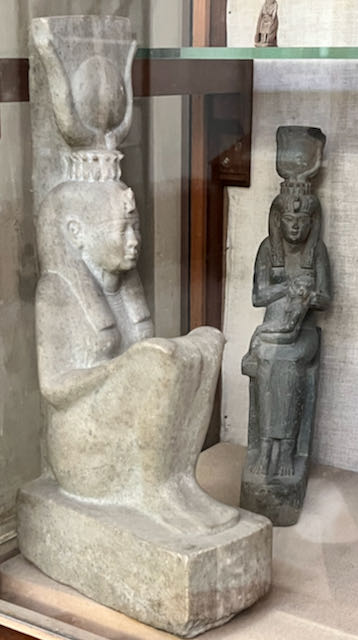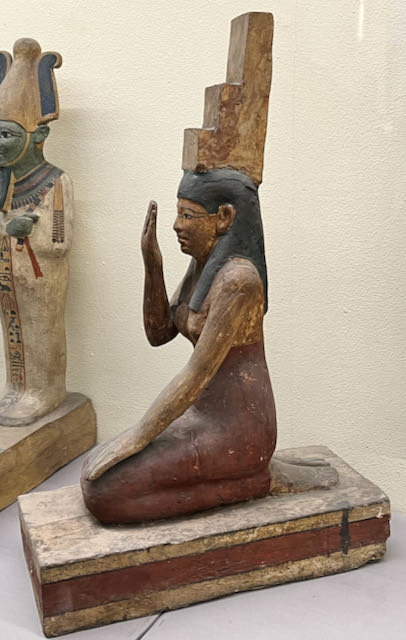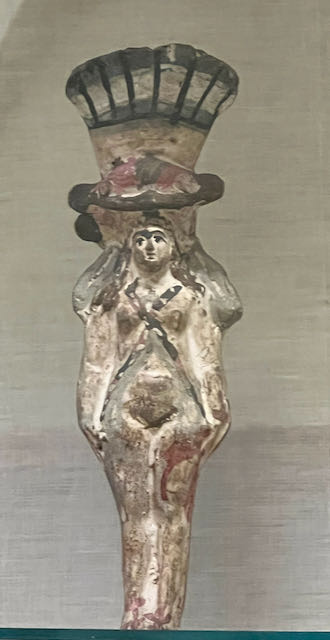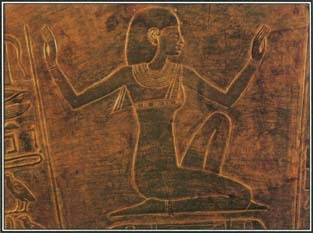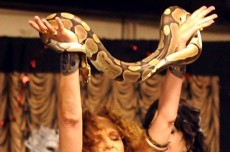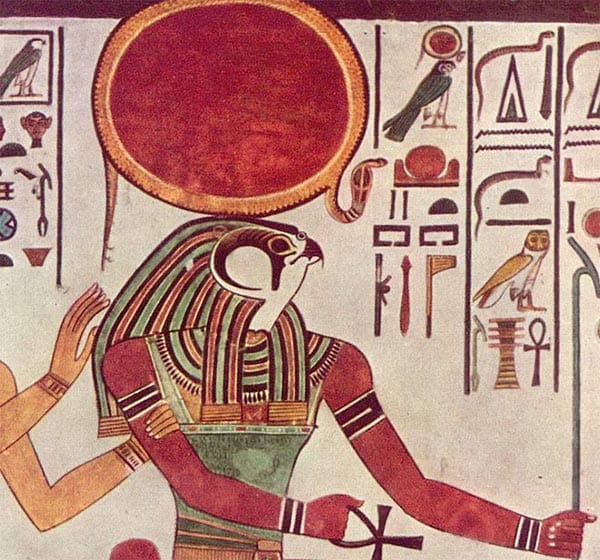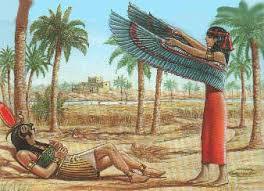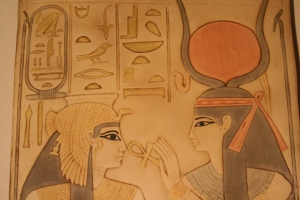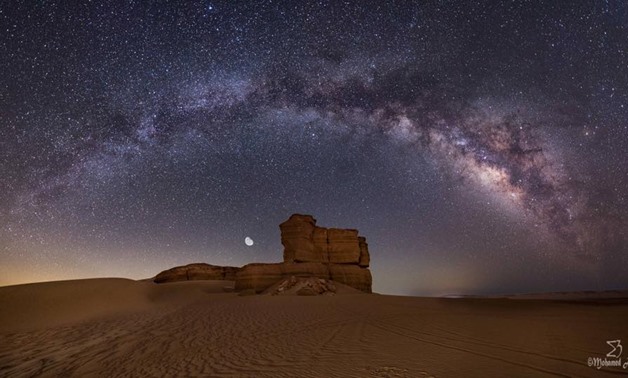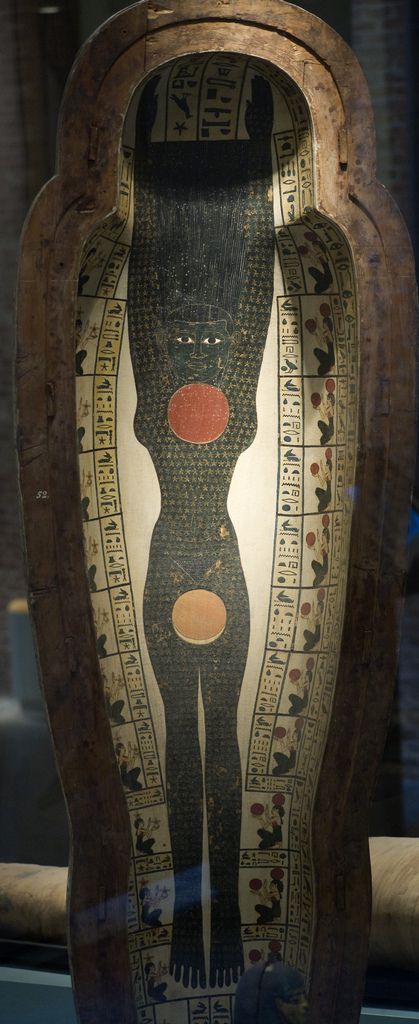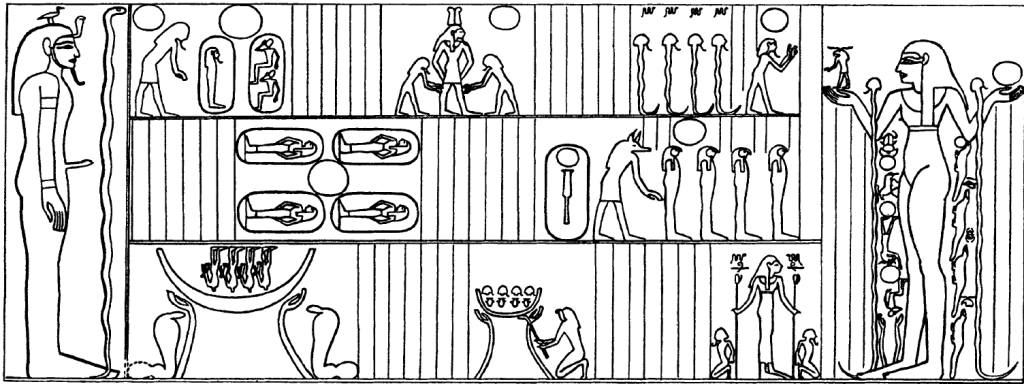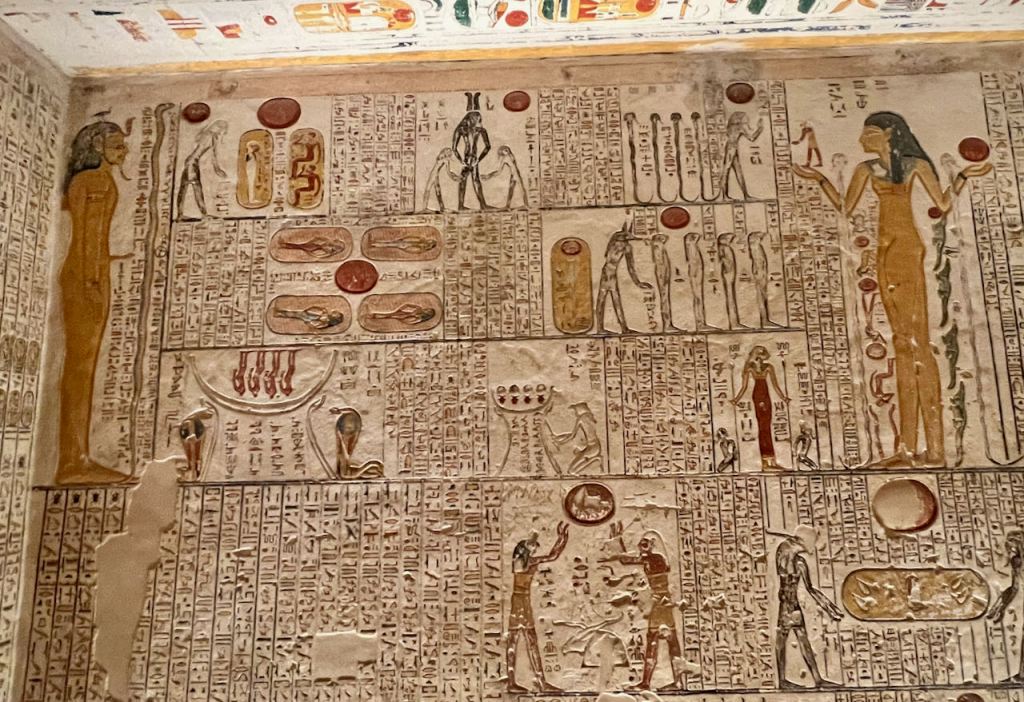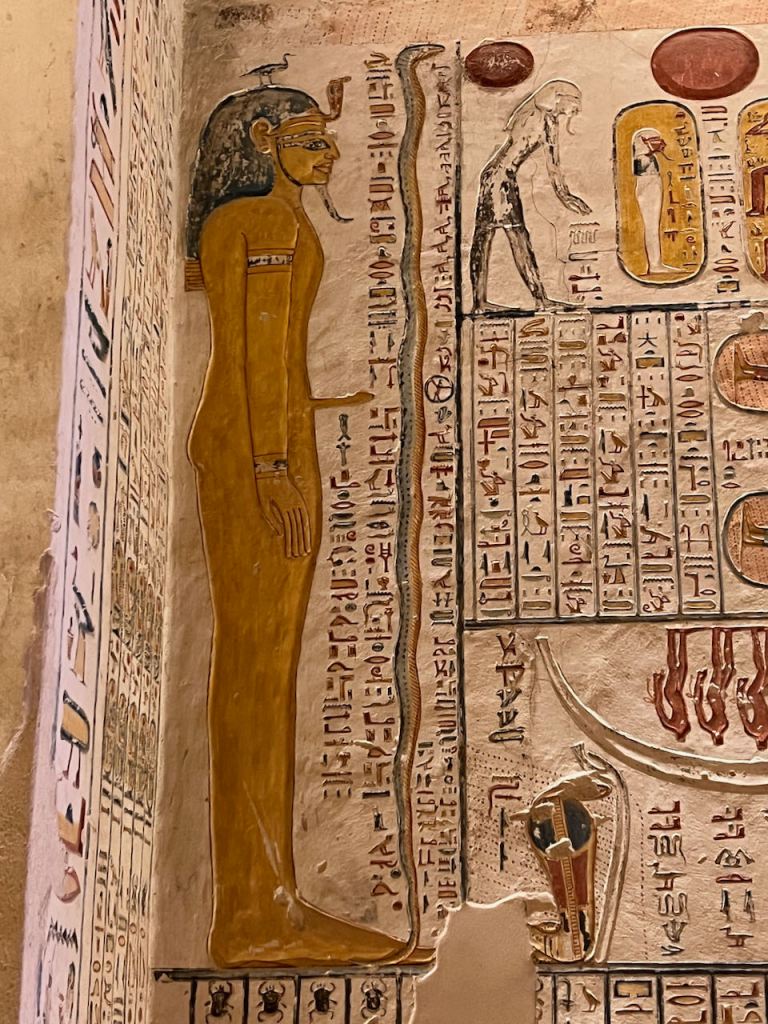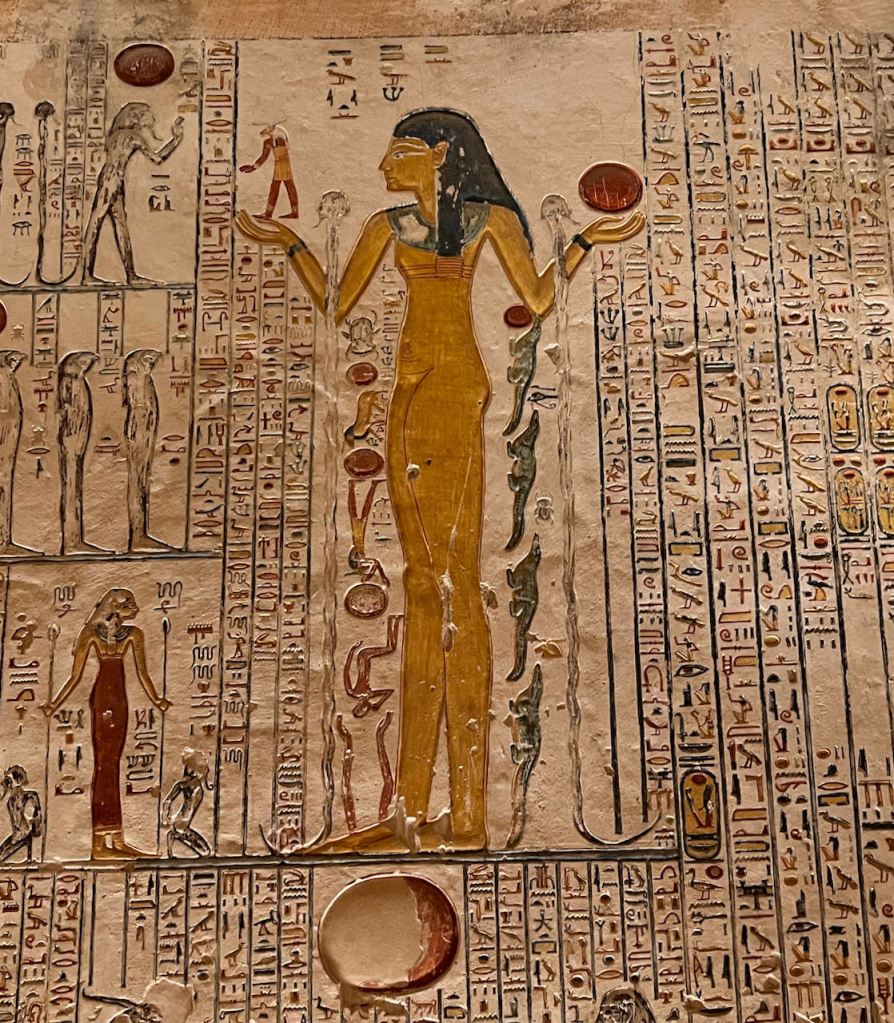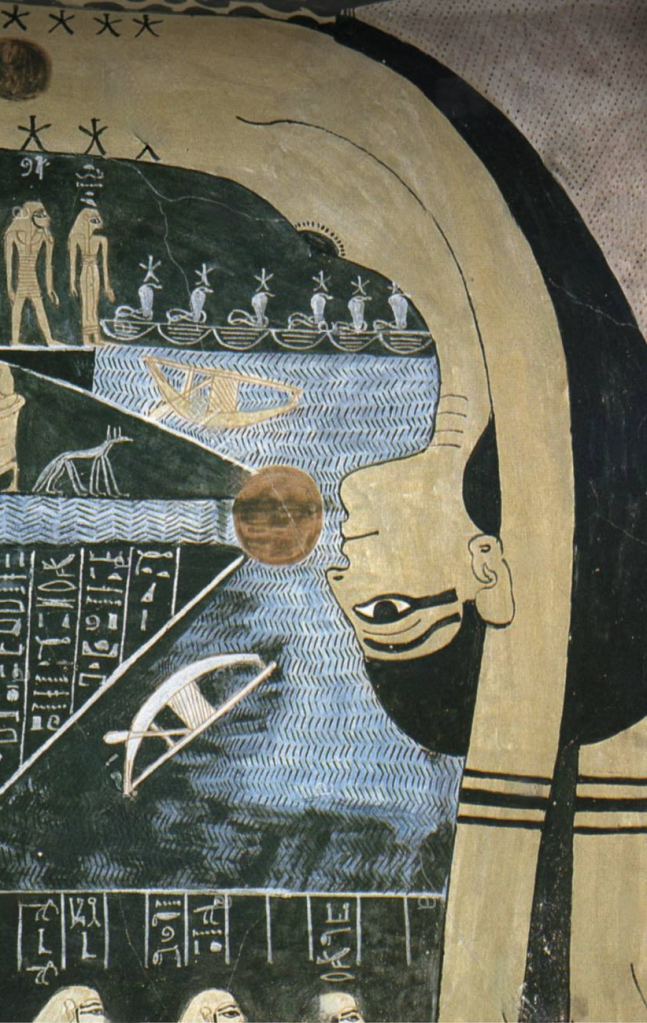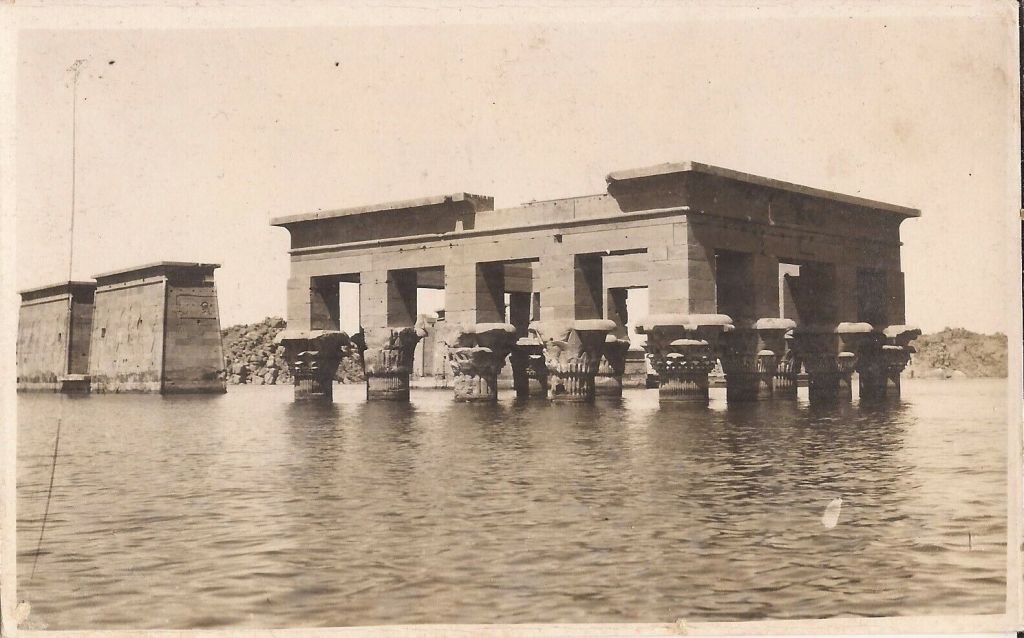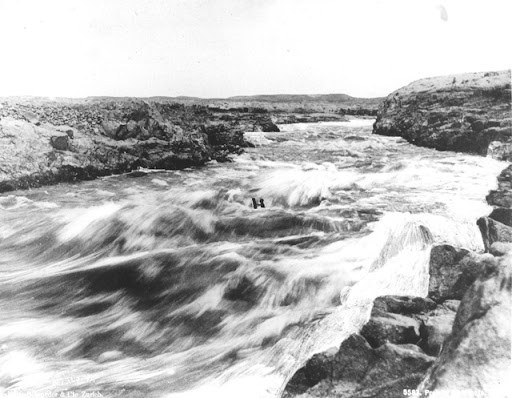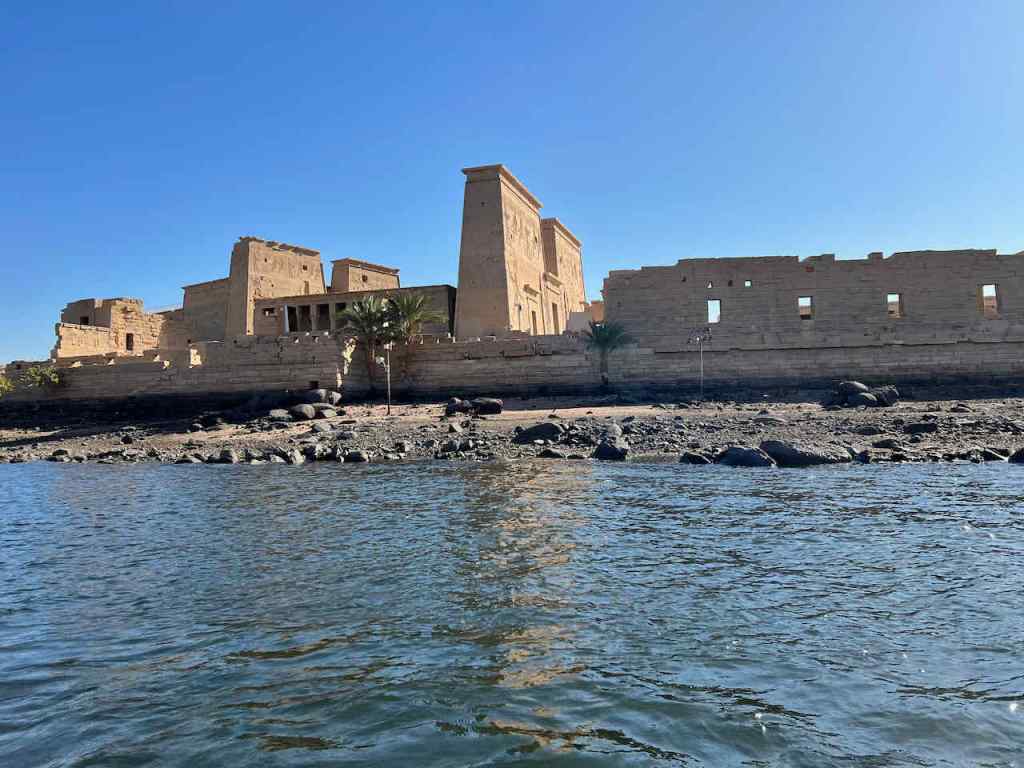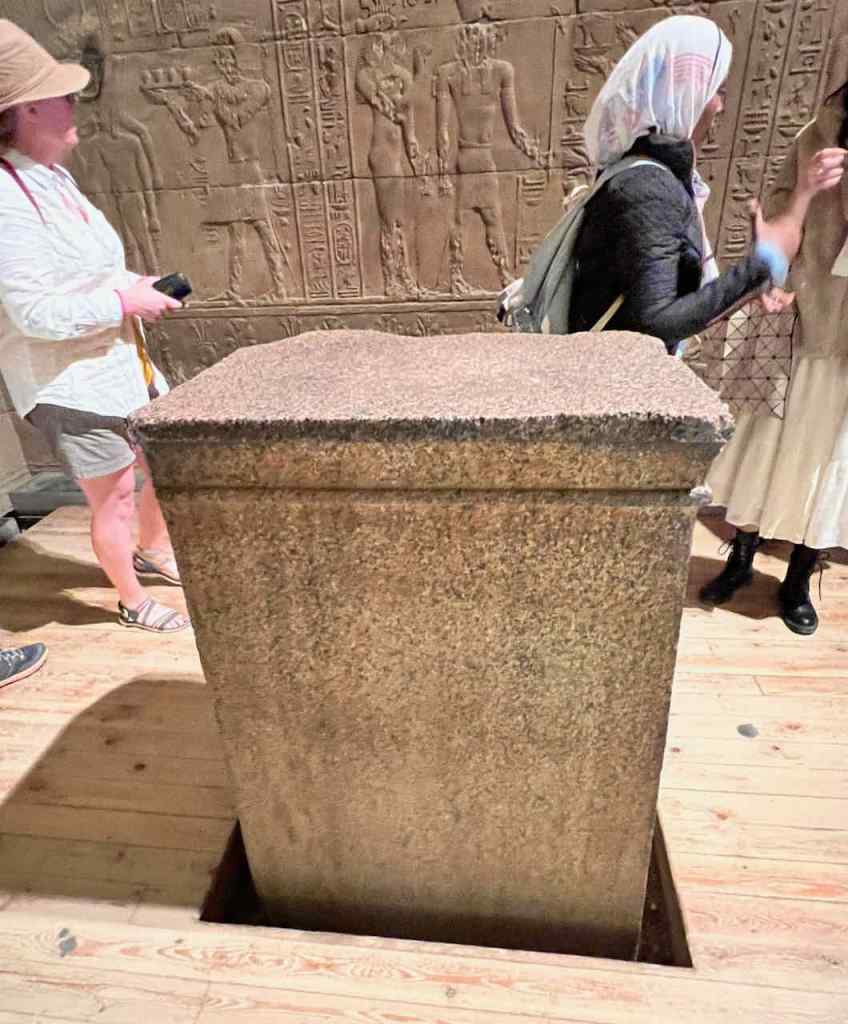I’m recovering today from a bit of surgery, so I will leave you with this photo of some Isis statuettes we were privileged to see at the Egyptian Museum in Cairo. Isis, Isis everywhere!
Category Archives: goddess
She Will Hear You
So many folks I know are going through something right now. I’m not talking about The State of the World. (That’s a whole other difficult story.) I’m talking about personal things that loom large in our own lives. Health. Family. Huge decisions. Scary changes.
Maybe it’s just spring?
Because as beautiful and as welcome as each spring is, there’s also something unsettling about it. Everything is roaring to get going. But we’re not quite there yet. And we can’t quite move yet. Do you feel it, too? I know I do.
So you may be wondering, “Where is Isis in all this?”
She is here.
As She has always been.

And She is listening.
Isis is one of the Deities particularly known to hear our human cries, to hear our prayers. She is called the One Who Listens. In ancient texts and on temple walls, Isis is She Who Hears Petitions; Who Hears the Petitions of Millions. She is particularly known to come at the invocation of Her devotees: Isis is She Who Comes to the Calling; people Call to Her in Every Place. A graffito from Thebes says, “O you of all lands, call to Isis, the Great Goddess, She listens at every moment!”
Why then does She not snap Her magical fingers and make it all go away? Because that’s not how it works. Whatever we are going through, these are our problems to solve. And we will solve them—with a little help from our friends.
Isis reminds us that we are each a feather in Her Wings, the blood in Her veins, an extension of the magic in Her heart and in Her hands.
This is a time not to neglect our connection with Her. Meditate, make offerings, chant. She invites us to let our souls fly to Her and be enfolded in Her Wings. “Bring your heart to Me,” She says. “Speak pain. Speak truth.” She will take us as we are right now.
For She listens. And She hears.
Happy Equinox!
Hello, Isiacs! I’m off celebrating the equinox today. Yes, it’s Portland and it’s overcast and chilly. But the daffodils are blooming and all the little green shoots are coming up.
So, no post today, but I’ll leave you with some images of Our Lady that I had the privilege to see at the Egyptian Museum.
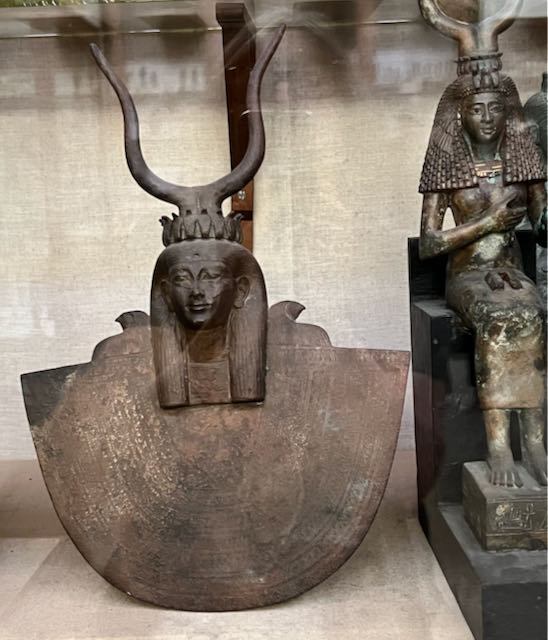
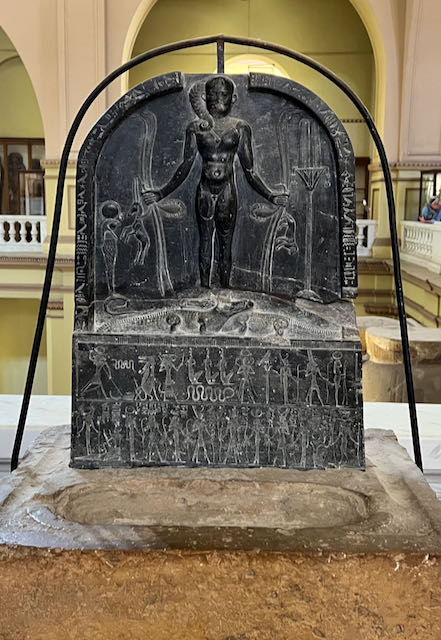
Many blessings to you and yours!
Under Her Wings, Isidora
Is Isis Calling Me?
One of the questions I regularly receive from folks who email me is, “how can I tell if Isis is calling me?” It’s a very good question, if a somewhat difficult one to answer.
Sometimes, people have had dreams with what they think could be Isiac imagery. Sometimes they’ve had a vision or some other experience during a ritual. Sometimes it’s a feeling, sometimes a wish or a hope.
To try to unravel this, the first thing we need to figure out is what we mean by “calling?” In other words, if She were calling us, what would that mean? What kind of obligation, if any, comes with that calling? Because so many of us have Christianity in our personal backgrounds as well as Christianity being so prominent in our societies, we might automatically associate “a calling” with a vocation for the ministry or priesthood. It’s certainly possible. But there are other possibilities, too.
What calling means to us can also depend on where we are in our spiritual journey, as well as what we’ve been studying or reading or thinking.
For instance, let’s say you’re very interested in ancient Egypt, you’ve been reading about it, and you’re in a spiritual circle of some kind that regularly invokes Deities. Then one night, you have a powerful dream in which a beautiful, Egyptian woman seems to welcome you. You think She might be Isis. She might, indeed. She could also be one of any number of Egyptian Goddesses, which you would know about from your reading. What you intuit from your own dream will be very helpful here. If you think She’s Isis, you can follow that thread. We’ll talk about that shortly.
For another instance, let’s say you’ve never had any particular connection with ancient Egypt and you’re not on any specific spiritual path. Then one night, you have a powerful dream in which a beautiful, Egyptian woman seems to welcome you. You think She might be Isis. This may be just a dream. But if you find it exceptionally powerful, keep looking. A dream like that might be pointing out that your soul is yearning for some positive Mother or Divine Feminine energy in your life. That knowledge, in and of itself, is very valuable information. On the other hand, such a dream could be the impetus to set you on a spiritual journey as you seek to learn more.
And for a third instance, let’s say you have that same dream. But you don’t feel that you’re ready—or that you even want to—do anything about it. You absolutely don’t have to. If it’s an important knock on your spiritual door, She’ll knock again. And it’s okay to say no. You won’t hurt Her feelings and there are no negative consequences.
So. Dreams are one way to hear Isis if She’s calling you. But if you, like me, are a crappy dreamer and neither remember them nor write them down, there are other ways to hear Her. There are usually signs. Signs can be tricky. In most cases, a sign is something unusual that catches your attention and relates to the particular Deity involved, in our case, Isis. Because She is a Bird Goddess, it might be wings and feathers. You may hear the sound of wings at an odd time. Or a bird swoops down immediately in your line of sight, startling you. Or a feather drops from the sky. Her symbols—like the Knot of Isis or a throne—might show up unexpectedly. Perhaps you overhear Her name in a passing conversation between strangers. This will happen, not just once, but many times. Be patient. Wait. And look and listen for the signs.
Now, if you’re actively wanting Her to be calling you, signs and synchronicities can ramp up. Does a breeze rustle the leaves of a tree as you pass, thinking of Her? It is Her breath. Have you found a piece of jewelry engraved with Her image? She confirms your Path. Did that hawk circle above you as you drive your car down a country road with Her name on your lips? She is guiding you.
Is it foolish to see these signs everywhere? Is it “just my imagination?” In some cases, sure, there will be a kind of confirmation bias. But that doesn’t matter; She’s on your mind. You’re thinking of Her. It has begun.
Sometimes, there are other ways to tell. You might have an intuition of Her presence about you. Or something weird might happen. I’ve had incense burn and disappear all by itself, strangers have given me unexpected Isis gifts, very loud disembodied voices have spoken my name. What your weird thing might be, I can’t say.
Now. There’s also an important secret about all this that I’d like to share with you. Two, really. The first is that if you want to connect with Isis, you don’t have to wait for Her to call you. You can call Her, too. Light a candle. Say a prayer. Ask Her to come into your life. If you like ritual, use the Opening of the Ways here.
The second is that being called by Isis doesn’t necessarily mean you are being called to a lifelong relationship with Her. It doesn’t necessarily mean you’re being called to serve as Her priestess or priest. It might mean you’re being called to learn more about Her—right now and perhaps only for a while. Perhaps you’re being called to relationship. And like any relationship, that means investing time. Spend time with Her, in meditation and prayer. Read about Her in anything and everything you can get your hands on. Get to know Her. See how She feels to you. Do you like Her energy? Does it fit with yours? That’s what I mean by following the thread…and just see where it leads you.
And if you find, after time, that this is not the relationship for you, that’s perfectly okay. You will have learned. You will have grown and your spiritual world will have been expanded.
But if you find that, like me, you are a lifetime (or at least longterm) devotee of Isis, then I know you will discover for yourself Her deep love, wisdom, power, and magic.
Isis the Avenger
We are about to turn the corner into spring here in the Northern Hemisphere.
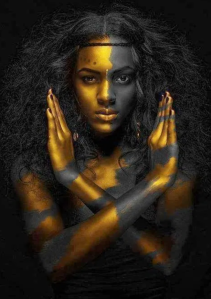
We often think of spring as soft and gentle. Tra-la-la, the flowers are budding, the birds are singing, the bunnies are doing as bunnies do.
But there is another side to spring. A striving, struggling, powerful side. Think Stravinsky’s Rite of Spring. After all, why is Aries the Ram the zodiac sign of spring? Because to get the year moving after long, deep winter, the world needs a push. Or a good shove. And the Ram is just the one for the job.
Just as we often think of spring as sweet and gentle, so do we often think of Isis as only sweet and gentle. And She can be. She can be a kindly mother holding us in Her arms as we weep and drying our tears. Then again, She can be fierce. She’s a Goddess. And She has many different faces.
So today, we have an Isis story that shows Her fierce and fiery aspect and which you may not have heard before.
This is a tale of Isis the Avenger and it is from the Papyrus Jumilhac. The only publication of the papyrus has been in French (which is why English readers may not have heard the tale). But via the blessings of interlibrary loan, I was able to borrow the French text.

The Papyrus Jumilac is about 23 “pages” long. It is a Ptolemaic text (approximately 2nd century BCE) but it was found in Upper Egypt and records some thoroughly Egyptian myths. It may have been a sort of training manual for the priesthood of the 17th and 18th nomes (administrative districts, like states or provinces) and tells stories connected with the local landmarks. Our Isis story from it is a tale of transformations, and in it, Isis changes Herself into a hound, a uraeus serpent, Hathor, and Sakhmet—all in Her pursuit of and revenge upon the murderer of Her husband.

Herewith is the tale of Isis the Fierce:
Set once more regrouped His allies, but Isis marched against them. She concealed Herself in Gebal which is south of Dunanwi, after having made Her transformation into Her Mother Sakhmet. She sent out a flame against them all, seeing to it that they were burned and devoured by Her flame. (It is said to Her, “Hathor, Mistress of the Two Braziers.”) She [Isis] created for Herself there, a place to observe the preparations of the Evil One and His allies. (It is said to Her, “The Temple of the Mistress of the Two Braziers,” and the wab priest of this Goddess is called Ouroumem [the Great Devourer].) Then Set, seeing Isis at Her observation point, transformed Himself into a bull to chase Her, but She made Herself unrecognizable and put on the form of a bitch with a knife at the end of Her tail. Then She began to chase Him, and Set couldn’t trap Her again. So He scattered His semen upon the earth, and Isis said, “It is an abomination to have scattered Your semen like this, O Bull.” His semen grew, in Gebal, in the plants which we call bdd-k3w.

Then the Goddess entered into the mountain which we call Hout-Kâhet, and settled Herself there. After which, She went to the north and, having transformed Herself into a serpent, She entered into that mountain which is north of this nome to spy on the allies of Set as they arrived in the evening. (It is said to Her, “Hathor, Mistress of Geheset.”) The Goddess [Isis] watched the allies of Set as they arrived in the Oxyrhynchite Nome and as they crossed the country to reach Gebal, the City in the East. She pierced them all [with Her fangs since She was in the form of a serpent], and She made Her venom penetrate into their flesh, so that they perished, all together; their blood poured out upon the mountain, and this is why this mountain is called the prsh of Geheset.
The story bears a little commentary to explain some of the features. Isis is pursuing Set in revenge for His having murdered Osiris. It is interesting to note that it’s not Horus the Avenger Who is going after Set, but Isis the Avenger. I’m not sure exactly where the local Gebal (a Gebel is a mountain) is; but we are told that it is south of Dunanwi. Dunanwi is a local God of the 18th Upper Egyptian nome, so perhaps the direction refers to a temple or shrine of the God or the text is using the Deity’s name as a name for the nome itself.

Although Isis’ first transformation is into “Her Mother” Sakhmet, Isis is repeatedly called by the name and epithets of Hathor, a local Goddess of Geheset. Geheset is a mythically powerful place; it hasn’t been conclusively identified with any real place in Egypt, but some scholars believe it may be at modern Komir, on the west bank of the Nile, south of Esna. (Interestingly, Komir was a center of the worship of Nephthys and a temple dedicated to Her has been found there. It is in the 3rd nome, however, south of the 17th and 18th nomes.) The Jumilhac papyrus does contain more information on Geheset. In another passage it says:

“Regarding Geheset, it is the temple of Hathor of Geheset, the house of the Chief of the Two Lands. House of Uraeus is the name of the Divine Booth of Hathor in this place. Isis transformed Herself into the uraeus. She hid from the companions of Set, Nephthys was there at Her side. The companions of Set passed by Her without their knowing. And then She bit them all. She threw Her two lances at their limbs. Their blood fell on this mountain, flowing, and their death happened immediately.”
Now, in the 4th nome, there was a famous Hathor cult center in Pathyris or Aphroditopolis, modern Gebelein. It is reasonably near to the Nephthys temple at Komir. If this is the mythical Geheset, then Nephthys being at Isis’ (as Hathor) side makes some geographic sense.
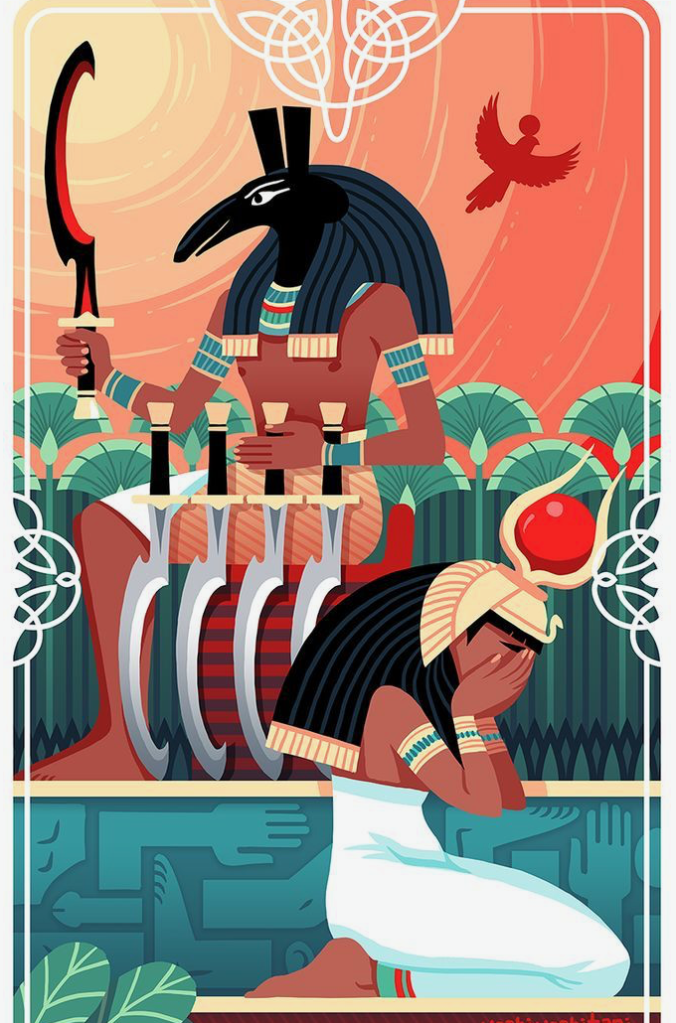
In the encounter between Isis and Set, in the form of a bull, Set attempts to rape Isis. We know this because He eventually ejaculates on the ground and Isis castigates Him for having wasted His semen like that. This reminds me of the myth in which Hephaestus tries to rape Athena, but His semen either falls on the ground or on Her leg, which She then wipes off in disgust and tosses it on the ground. The semen fertilizes Gaia and the Earth gives birth to Erichthonius, a mythical ruler of Athens who may have been part serpent. In this case, the semen of Set becomes an unidentified local plant called beded kau; the kau part is the plural of ka or vital essence. This may indicate that it was considered a powerful plant.
For the final part of the tale, Isis Herself takes the form of the holy cobra, the uraeus serpent. As a great serpent, She kills all of Set’s companions with Her venom. Their blood pours out on the mountain and becomes juniper berries (prsh); there is an Egyptian pun here on juniper berries and the flowing out of blood. In another part of the Jumilhac papyrus, Isis “cut up Set, sinking Her teeth into His back” and in yet another She first transforms into Anubis, “and having seized Seth, cut Him up, sinking Her teeth into His back.” (I wonder if there some connection between Isis transforming Herself into a dog with a knife in Her tail and later into Anubis?) Also, it is highly unusual for a Goddess to transform into a God. Usually, the Divine transformations are same sex.
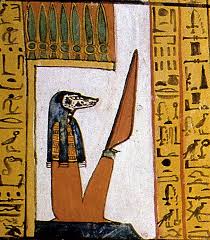
The myths recorded in the Papyrus Jumilhac are surely much earlier Egyptian stories, which the priesthood used to teach their traditions in the temples of the 17th and 18th nomes. There were almost certainly other tales like these, from other nomes, in which it is Fierce Isis Herself Who takes revenge upon the murderer of Her beloved Osiris. I hope someday we will find more of them.
As we enter into our own rites of spring, I hope that the Fierce Goddess Isis will always protect you and empower you.
Art of Isis
I’d like to share with you some beautiful art of Our Lady that was shared with me recently.
I absolutely adore the fact that She inspires so much art. It seems that sometimes art is the only way we can express our feelings for Her or our experiences with Her. For me, often, it is the art of ritual that helps me both express and share my love of Her. For others, it’s poetry or visual arts or music. What about you? Is there an art that you use to express yourself about or to Her?
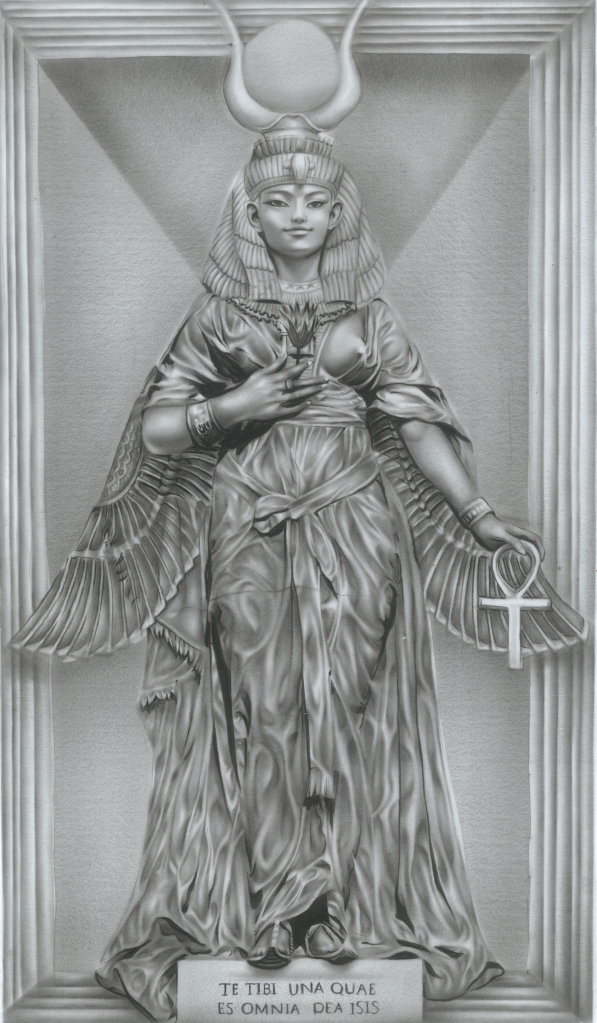
The artist is Lupherd Hernandez Lozada.
The Latin beneath Her feet says, “You, being One, are All, Goddess Isis.”
And here are some photos from the Egyptian Museum in Cairo that inspired this lovely sacred image:
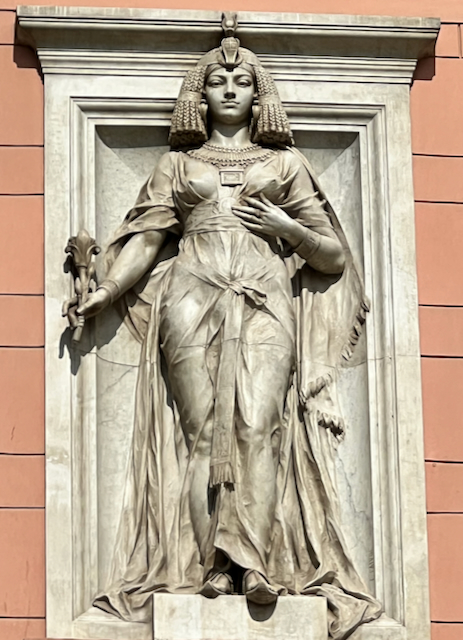
But according to the Egyptian Museum itself, They are Goddesses representing Lower Egypt and Upper Egypt. The Goddess above is the Goddess of Lower Egypt with the uraeus on Her crown…so Wadjet.


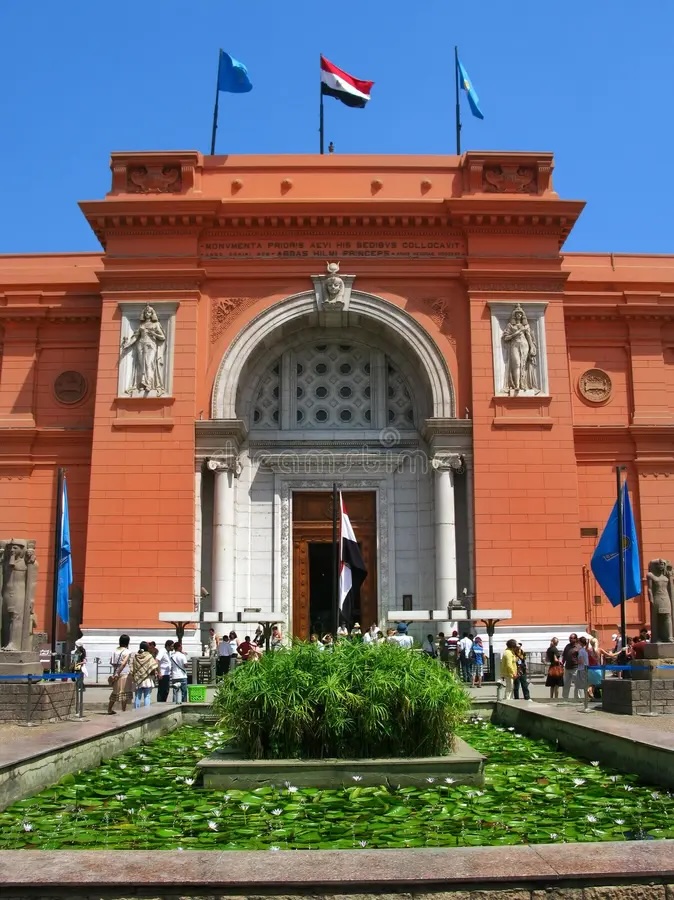
So, do you do art about or for Isis? Please feel free to share in the comments.
The Disturbing Story of Isis & Re
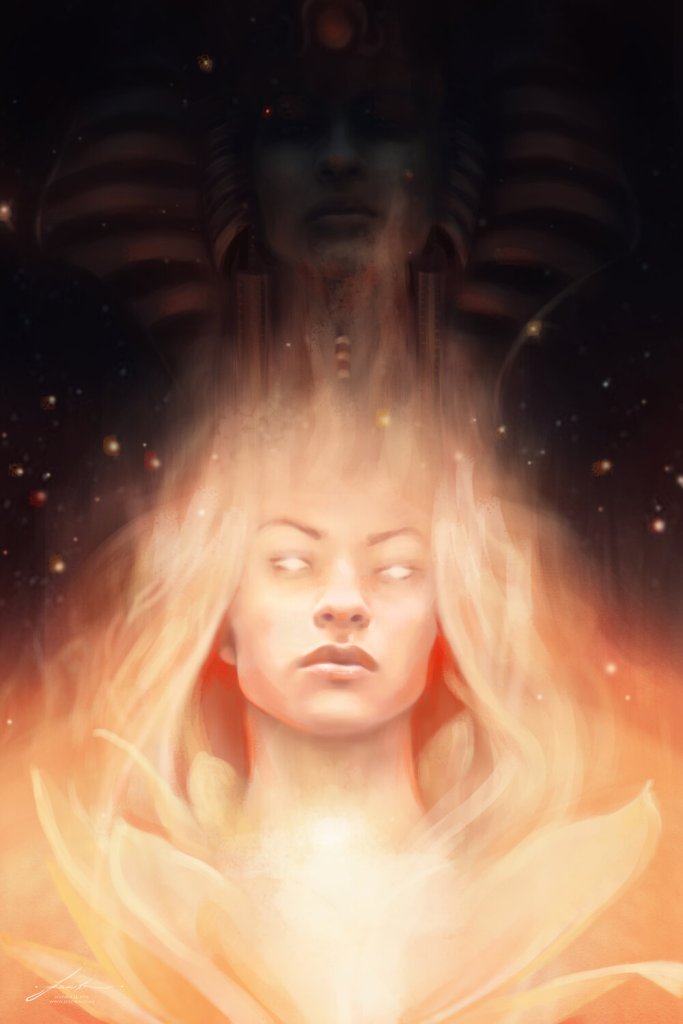
This is an important Isis myth. It almost always gets overshadowed by the main Isis and Osiris myth, the murder of Osiris and Isis’ search for Him. But this is the Isis myth that is, for many, the most unsettling when we are first learning our Isis lore; and that is the tale of how Isis tricked the Sun God Re into revealing His most secret name and thereby gained additional power for Herself and for Her son, Horus. Know that story? If not, you can read a translation here.
On the basis of this tale, some have decided that Isis is an evil magician. I have even seen the story used as an argument to show how naturally underhanded all women are! And, on the face of it, the tale is troubling. Isis decides to gain power. She deliberately poisons Re, then cures Him only after He reveals to Her His most secret, hidden, and powerful name. Although Isis’ Divine knowledge is already equal to Re’s, knowing His name gives Her even more power. What’s more, She will be able to share Re’s name with Horus, once He is oath-bound to keep it secret, and Horus will receive the sun and moon as His Two Eyes.
So what are we to make of this? Is Isis just another tricky female? Perhaps we should consider Her as one of the Trickster Deities. She’s a Divine Magician, after all, and magicians are always tricky. Or maybe Isis was forced to resort to magical artifice to break through a Divine glass ceiling. Think of royal women in the Egyptian court. Because they did not have outright power equal to men’s, they would have used tricks, subterfuge, perhaps even poison, as a path to power. We must remember that it is always human beings who tell these stories, thus all stories come through a human filter.
As you might guess, none of these explanations satisfy me. I do have one that does, but it will take me a little while to get to my point, so I hope you’ll bear with me.
Background Info
There are several things you should know about this story. First, the version of the tale that has come down to us is from a papyrus known as the Turin Papyrus (along with a few other sources). It has been dated to Egypt’s 20th dynasty, about 1186-1169 BCE. No doubt, the story itself is much, much older, but the version we have comes from the later time. Second, the story is part of a healing formula to cure snakebite. Egyptian medicine almost always had a magical prescription as well as whatever herbal or surgical therapy was given. Such prescriptions often included a myth that related to the problem, followed by a statement that just as so-and-so was cured in the myth, so shall the sufferer be cured. In this case, just as Re was cured by Isis, so shall the snakebite sufferer be cured. Instruction is given at the end of the formula to recite the story over images of the main characters in the tale.
Elements of the Myth: the old king
The papyrus tells us that Re was so old that He drooled. In a time when the pharaoh was considered a God, and therefore should be the epitome of physical, mental and spiritual perfection, it would hardly be acceptable to have a ruler so old He drooled. Myths such as the death of the Holly King in Celtic countries, ritual combat to the death between the outgoing priest of Diana at the grove of Nemi and an incoming hopeful, and Arthurian legends of the Wounded King of the Wasteland—all point to the archetypal nature of this theme.
Elements of the Myth: the Goddess of Renewal
If you know anything about Isis, you know that one of Her key powers is the ability to renew and resurrect. The Turin papyrus tells us that Isis came to Re with Her magic and that Her “speech was as the breath of life.” When the Star of Isis, Sirius, rose in summer, it signaled the beginning of the New Year and the renewal of all things. Her magic brought Osiris back to life enough to conceive Horus and then gave Him a new existence as Lord of the Dead. As some of you may know, I believe Isis is the ancient Bird of Prey Goddess. Thus She is the Lady of Death and Regeneration, an identity that She has never lost, even to this day. Since the failing Re does not willingly give up His power, Isis must create the conditions that force the old ruler to the point of renewal.
Elements of the Myth: the saliva of the God
In Egypt, magic might be worked by means of bodily fluids. Saliva, semen, blood, sweat, milk, and other such fluids were a means of creation. If it was the blood, sweat, and tears of the Deities, it was even more creative and powerful. Since Re drooled, rather than purposefully spitting (for example, when Atum creatively spit to give birth to the Goddess Tefnut), He was wasting His power.
Elements of the Myth: the holy serpent
Yet, the Goddess does not let it go to waste. Instead, She mixes Re’s drool with earth, the place of renewal from which new life grows, to create a holy cobra (or “noble snake” as in the linked translation). The cobra is a mixture of life—in that it is made partly of earth and will ultimately cause Re to be healed—and death—in that it is made from the wasted generative power of Re and is a symbol of His unfitness for His throne. And of course, the serpent is an almost universal symbol of renewal due to the snake’s ability to shed its skin and emerge new from the experience.
In the form of the holy cobra, Re’s own weakness strikes Him and brings Him more pain than He has ever before experienced. He quakes with cold and burns with fire.
Elements of the Myth: name magic
In Egyptian magical theory, to know someone or something’s name is to be able to access its essence at the time of Creation, when all heka was at its more pure and potent. In this story, Re is considered the most powerful Deity in the universe (the tale also contains a litany of Re’s great powers). Knowing His secret name confers ultimate power; including the power to heal. As Isis tells Re, “the person who hath declared his name shall live.”
If this story is very ancient, it may be that its original form, in which Isis renews Re simply because that’s what the Goddess does, was lost. Perhaps later scribes tried to explain the Mystery to themselves and their audiences by framing it as a trick to gain power. Thus what may seem like simple blackmail is actually much more profound. Re is being forced to reveal a most secret and inner part of Himself to the Goddess. To be healed, He must make Himself vulnerable to the Lady of Renewal. He must accept both Her help and Her very real power.
Once Re gives Himself over to Isis, He is healed, renewed in strength and power. He learns that He must give up in order to gain. He learns to trust the Goddess Whom He has been forced to trust. And the Goddess proves Herself worthy. In no successive myth do we ever find any evidence that Isis abuses the ultimate power She has gained.
But Wait, There’s More
In the very same papyrus in which this story is found, there is a parallel story involving Horus and Set. It, too, is a magical snakebite cure. Here’s that story:
Horus and Set were voyaging together on Horus’ golden barque. Suddenly, Set cried out, “Come to me Horus, I have been bitten!”
And Horus turned to Set and said, “Tell Me Thy name, that I may work magic for Thee. One works magic for a man through his name, and a God is greater than His reputation.”
Set replied, “I am Yesterday, I am Today, I am Tomorrow That Has Not Yet Come.”
But Horus said, “No, Thou art not Yesterday, Today, or Tomorrow That Has Not Yet Come. Tell me Thy name, that I may work magic for Thee. One works magic for a man through his name, and a God is greater than His reputation.”
So Set said, “I am a Quiver of Arrows, I am a Cauldron of Disturbance.”
“No, Thou art not,” said Horus and repeated what He had said before.
“I am a Man of a Thousand Cubits, Whose Reputation is Not Known.”
“No, Thou art not,” said Horus and repeated again what He had said.
“I am a Threshing Floor; I am a Jug of Milk, Milked from the Breast of Bastet.
“No, Thou art not,” said Horus again.
Finally, Set replied with His True Name, “I am a Man of a Million Cubits Whose Name is Evil Day. As for the Day of Giving Birth or of Conceiving, There is No Giving Birth and Trees Bear No Fruit.”
The formula concludes with the promise that the sufferer will be made as sound as Horus was by Isis, so even though in this story Horus is one Who is pushing Set to reveal His true name, the cure is attributed to Isis.

What the Trickster Teaches
It seems clear to me that a key to both of these myths is vulnerability to the Divine that precedes healing. We must reveal our innermost selves, symbolized by our true name, to Goddess, to God. We must do so even if, like Set, it is a name with which we are not entirely comfortable. We must give ourselves over to the Divine, as we are, right now, with no masks. Only in this state of radical openness can we receive the renewing gifts that Divinity has for us. Like Re and like Set, we must—at least eventually—be willing to acknowledge and trust the Divine in order to bring Its power into our lives. This vulnerability and revelation of truth can be painful, like poison; and yet the truth always frees us.
Like Re especially, we must acknowledge the power of Goddess and make ourselves open to Her. If we don’t, She will find a way—perhaps a rather difficult way—to bring that lack to our attention. But when we do reveal ourselves to Her, we can know Her and be known by Her. We can enter into mystical communion with Her as we move through the natural cycle of death and renewal that is guided by Her hand.
Isis, the Birth Goddess & Lots of Bricks

Egypt is a land of bricks. From the ancient sun-dried mudbrick temple enclosures to modern Egyptian apartments, everything was and is made of bricks. (And, modernly, supplemented by concrete.)
It’s because there never were many trees and the native ones aren’t very suitable for large building projects. Even anciently, building wood was imported.
So bricks were and are still the answer. the ancient Egyptians encountered bricks on the way into life, during life, and on the way out of life.
The ones they encountered on the way into and out of life were special. There were magical.
On the way into life, there were four bricks, stacked in pairs, that served to elevate a birthing mother so that when her child emerged beneath her, the baby could easily be caught in the hands of the midwife. (According to midwives even today, a squatting or sitting posture is preferable to the supine position in which most modern Western women give birth, generally resulting in a faster, easier delivery.)
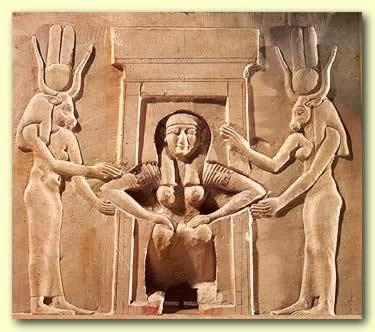
On the way out of life, there were the four talismanic bricks that were placed in niches in the four sides of a burial chamber. These bricks were decorated with amuletic figures: in the east, the Anubis jackel; in the south, a flame; in the west, the djed pillar of Osiris; and in the north, a mummiform male figure. All of them protected the deceased.
Doubtless, the talismanic bricks that surrounded the body of the deceased in the tomb were meant to assist in rebirth into the next life, just as the birthing bricks assisted in a child’s birth into physical life.
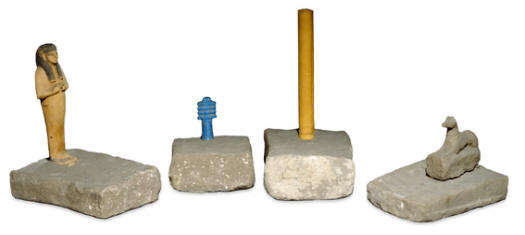
The Goddess most closely associated with the birthing bricks is Meskhenet, Protectress of the Birthing Place. The bricks were called meskhenut (pl.) after Her. Meskhenet is depicted either as a woman-headed birthing brick or as a woman with a distinctive curling headdress that has been identified as a stylized cow’s uterus. She protects mother and child during the dangerous process of birth, She foretells the child’s destiny as the baby is born, and She is among the Deities of rebirth Who witness the judgment of the deceased in the Otherworld.
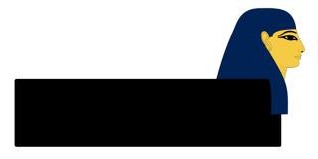
With Isis’ own connection to both birth and rebirth, you will probably not be surprised to learn that Isis is closely associated with Meskhenet. At Osiris’ temple complex at Abydos, four Meskhenets serve as assistants to Isis in the great work of rebirth done there. At Hathor’s temple complex at Denderah, a combined form of Isis and Meskhenet (Meskhenet Noferet Iset or Meskhenet the Beautiful Isis) is one of the four Birth Goddesses of Denderah. And in the famous story of the birth of three kings found in the Westcar papyrus, both Isis and Meskhenet are among the four Goddesses Who assist in the kings’ births.
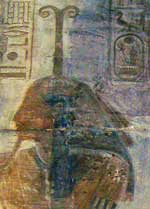
Both tomb bricks and birthing bricks were protective. In an inscription from the temple at Esna, Khnum, the God Who forms the child’s body and ka on His Divine potter’s wheel, places four Meskhenet Goddesses around each of His various forms “to repel the designs of evil by incantations.” As Birth Goddess, Meskhenet is associated with the ka as well. A papyrus in Berlin invokes Her to “make ka for this child, which is in the womb of this woman!”
We have a few surviving spells that were used to charge the birthing bricks. They were used to repel the attacks of enemies to the north and south of Egypt and may indicate that the birthing bricks, like the tomb bricks, were connected with the directions.
And here’s another tidbit showing parallels between the magical tomb bricks and birthing bricks. In an Egypt Exploration Society article by Ann Macy Roth and Catherine H. Roehrig, the authors point out an interesting gender-reversed aspect of these magical bricks.
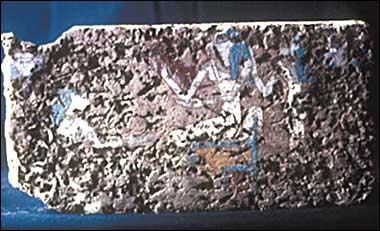
You may recall that four Sons of Horus are the Gods Who protect the four canopic jars that contain the internal organs of the mummy. These four Gods are, in turn, guarded by four Goddesses. In Tutankhamun’s tomb, the Goddesses are Isis, Nephthys, Selket, and Neith. Roth and Roehrig suggest that we may be able to explain the amuletic figures associated with the tomb bricks in a similar, though opposite, manner. If the four meskhenets are personified as four Goddesses Who protect the birthing place, perhaps the four figures on the tomb bricks—the God Anubis, a mummiform male, a Divine pillar associated with Osiris, and a flame, the hieroglyph for which is rather phallic—may be considered Divine Masculine Powers Who protect the four Meskhenet Goddesses, just as four Goddesses protect the four Sons of Horus.
It is worth noting that these magical bricks were made in the same way as were the traditional mudbricks of Egypt. They were fashioned from the fertile Nile clay and sand, mixed with straw, which may be associated with Isis as Lady of the Fertile Earth, then they were dried in the brilliant heat of Isis-Re, the Radiant Sun Goddess. And, of course, as a Divine Mother Herself, Isis is connected with every aspect of human and animal fertility, from conception to birth, as well as the protection of the children as they grow.
As we have a south-to-north flowing river here in Portland, I might see if I can get some Portland “Nile” mud to create four miniature mudbricks. Then I could magically charge them by naming them “Meskhenet Noferet Iset” and placing them in the four quarters of the temple—or even outside, one on each side of the house. They might provide some very fine magical protection.

Nuet, the Secret One
While I have no declared priestesshood for Nuet, She draws me. A lot. In fact, almost anytime I do spiritual work with Her, I am overawed by Her Eternity, Her Depth, Her Beauty, and I want to lose myself in Her.
Nuet is the mother of Isis. And She is also the One Who Bears All the Gods and Goddesses, and so She is called the Mistress of All. She is the Splendid and Mighty One in the House of Her Creation. She is the Great One in Heaven and the “indestructible stars” (that is, the circumpolar stars that are always visible) are said to be in Her.
She embraces the deceased “in Her name of Sarcophagus” and “in Her name of Tomb.” She is the Mistress of the Duat (the Otherworld). She is the Glowing One (as the Milky Way) and in Her we are joined to our stars, Becoming divine. She is the one Who gives birth to us and Who welcomes us back into Her starry body at our deaths. She is Heaven and She is the Otherworld. She is the one Who is “Amid the Iset Temple in Denderah” for She is over Her daughter Isis and Her daughter is both in and of Her.
As Nuet gives birth every day, She is the quintessential Mother Goddess. She births the Sun God Re each day and receives him back into Her body, by swallowing Him, each night. She also gives birth to Him yearly at the winter solstice. A cycle within a cycle within the Mother.
The decan stars, by which the ancient Egyptians kept time throughout the night, rise and set within Her heavenly body and so She is also a keeper and regulator of time. In one instance of what Egyptologists refer to as a “shadow clock,” the Hours of the Night are counted off in relation to where the sun is on/in Nuet’s body: First Hour, “hand,” Second Hour, “lip.” Third Hour, “tooth,” Fourth Hour, “throat,” and so on.
Most ancient Egyptian painted representations of Deities show Them in profile. Yet there are a few Who come to us face-forward. The Great Goddess Hathor is famously depicted that way, as is Bes, the God Who is a protector of households, children, and mothers. Interestingly, we also find Nuet shown in this way. Like Hathor, She is a Mother Goddess and like Bes, She is a mighty protectress.
We often find Her on the inside of a coffin, stretched out over the deceased person like the sky, positioned face-to-face with them. This face-forward, face-to-face position is particularly intimate, particularly appropriate for the close relationship with a mother…or a Mother Goddess. Yet facing forward is also a protective stance. We see some of these face-forward Deities holding dangerous beasties (scorpions, snakes, crocodiles) harmlessly in Their hands, demonstrating how They can protect us from real as well as metaphorical beasties. Isis’ son, Horus the Child or Harpokrates, is often shown in this way on what are known as Cippi of Horus.
Nuet has another interesting epithet that is found in the Otherworld books known as The Book of Caverns and the Book of the Earth. Just like the more-famous Book of the Dead, these are magical texts to assist the dead in the Otherworld.
In these books, there is an important Goddess known as the Secret One, the Shetait. Egyptologists generally believe that this is an epithet of Nuet. As the Secret One, Nuet can be seen, not face-forward, but standing between serpents and crocodiles that She has tamed on behalf of the Sun God (and thus the deceased). Her power over them is in the form of heat or fire. They “stay in their place due to the fire, the heat which is in this Goddess,” says the Book of the Earth. The Book of Caverns says that the Goddess “is secret of form, being in their darkness as a flame to which the gods cannot ascend.” She is thus a fiery Light in the Darkness, a flame that protects and illuminates.
And now, back from Egypt, I’m excited to have my very own photos of the illustration above. You should have heard me squeal when I recognized it in the tomb! Here it is:
The Secret One holds in Her hands a sun disk and, in this case, a ram-headed God, or sometimes a ba-bird. Either represents the Sun God, Who is in the process of being regenerated and reborn. Thus, the Secret One holds this process in Her hands.
The Book of Caverns tells us that the Secret One’s head is in the upper Duat while Her feet are in the lower Duat. The Sun God travels upon Her arms, but at the same time is hidden by Her from the Gods, the akhu (the transfigured, light-filled, potent spirits), and the dead. The process of rebirth is delicate and must be hidden until the proper time. In the Book of the Earth, it is said that “the Double Ba, He travels Her body.” The Double Ba is the conjunction of Re and Osiris—something that must also happen in the Duat in order for the sun to be reborn.
In Her Name of Sarcophagus, Nuet spreads Herself out over the deceased and then She is called Shet Pet. Shet Pet is a common epithet of Nuet’s and means “Coverer of the Sky.” With a little bit of the word play for which the ancient Egyptians were so well known, this epithet can also be interpreted as the Secrecy of the Sky (Sheta Pet) reinforcing Nuet’s identification as the Secret One.
With Her doubled snakes and containing the Double Ba, Nuet can also split Herself in two and become manifest as Her two daughters, Isis and Nephthys. Just as Nuet unites the east and west with the arch or Her body across the sky, so Her daughters form a unity as They position Themselves to the right and left of Osiris or They are to be found framing either side of one of the illustrated scenes in the Otherworld books.
The Secret One is, for me, a particularly potent epithet of the Goddess. It tastes of Her Mystery, the great Mystery of Life and Death and Rebirth. It speaks of Her Eternity. It breaths forth Her Depth and Her Power.
The Island of Isis
For me, of course, a highlight of our recent Egyptian pilgrimage was the visit to Her temple at New Philae, or Agilika (or Agilkia), island.
So I thought I’d share some photos with you so you can see what it looks like from more angles than you might usually get to see. There are more exterior shots than interior because the interior of the temple was freaking FULL of tourists. (Tourist tip: if you go, go as early or late as you can. We neglected to do this.)
But first, do you know the story of how they moved this temple, considered the most beautiful of all Egypt’s surviving temples? If not, I’ll tell it briefly…
With the building of the second Aswan dam in 1971, the Temple of Isis on the original Philae island was flooded.
Happily, it does not look like this today thanks to an enormous international effort that moved the entire temple—block by block—to a new and higher island, which was landscaped to look like the original.
Ancient Philae was situated at the Nile’s first cataract, the beginning of Nile whitewater, which was much more dangerous before the building of the dam. This area was where Egypt ended and Nubia began. Thus Aswan, the nearest town, became a huge market town. Aswan’s original name, Sunu, means “market.” The Nile is beautiful everywhere, but the cataracts are, I think, exceptionally beautiful—and an appropriate place for the beautiful temple of the Beautiful Goddess.
While the dam had calmed the waters, it had flooded Philae. To save the temple, UNESCO and the Egyptian government worked to move the Philae temple. But that wasn’t all. There were about 20 temples that were flooded and moved, including the spectacular Abu Simbel temples. But our story today is Philae-centered.
To save Philae, they built a retaining wall around the island, then pumped the water out of it.
After that, they were able to deconstruct the temples and monuments, move them, and reassemble them on the re-landscaped Agilika island. You can still see the numbering on some of the temple’s blocks that helped the team rebuild it. And you can also still see the darkness that seeped into the temple’s sandstone blocks from the black, silt-filled Nile waters during its time underwater—the same silt that made the Inundation so important for the fertilization of Egypt’s fields every year. With the dam, there is no longer an Inundation, but there is water control and there is electricity. By the way, none of this was easy or quick. It took from 1972 to 1980 to accomplish.
Our guide told us that the star alignment for the rebuilt temple is slightly off. But I haven’t been able to check that out for myself.

I will tell you one thing that shocked me. I knew that images had been purposefully damaged (not only at Philae, but at every temple). But the extent of the damage! Almost all of them. As in the image above, the faces were hacked away, and often the hands and feet as well.
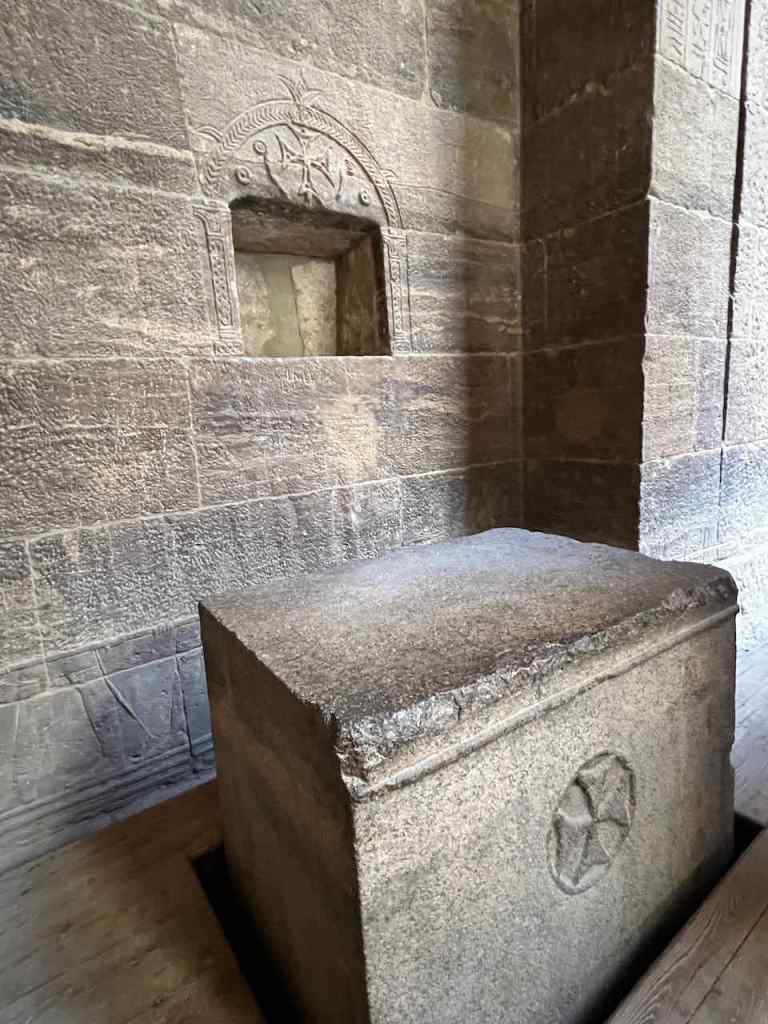
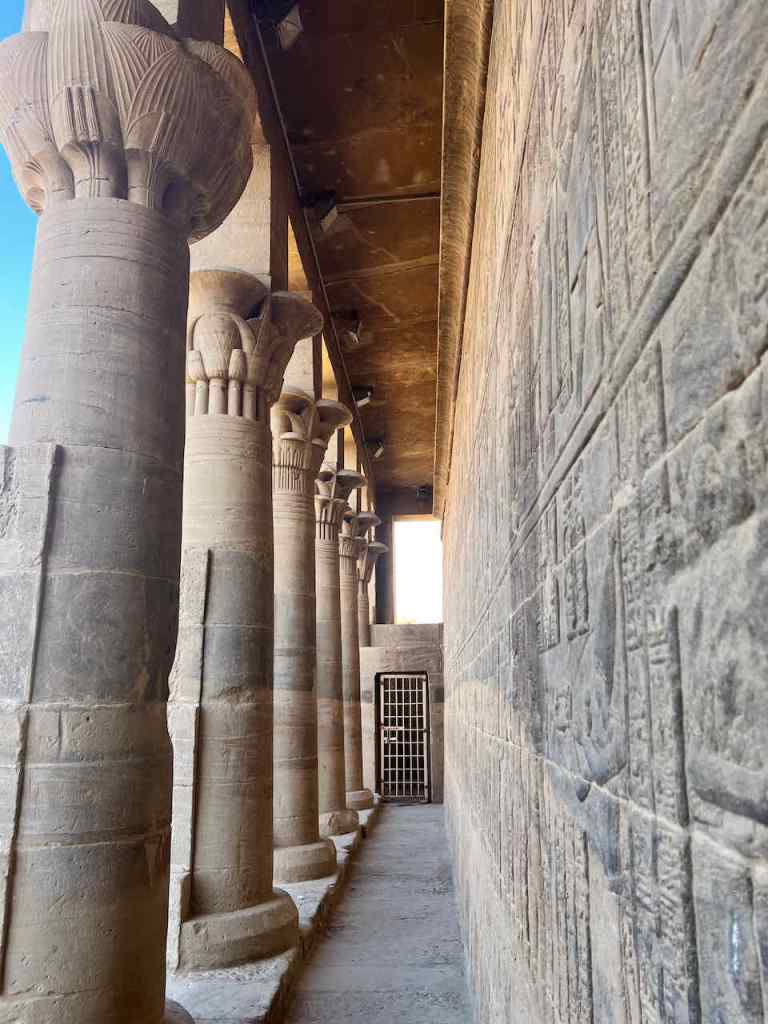
Visiting an Isis Temple at Giza
If you missed getting an Isiopolis post during the last couple of weeks, I have a very good excuse.
I was in Egypt. Finally.
And yes, it was amazing. On multiple levels.
Those of you who have already visited Our Lady’s homeland know. Those of you who haven’t yet, I hope you’ll be able to make the journey someday.
Now, if you’ve been reading along with this blog, you might know that I’ve never been overly interested in the kings and queens of ancient Egypt. For me, it’s always been about the Deities. And one in particular.
Given that, I’ve never been super-fascinated with the pyramids—other than by the sheer fact of their ancient eminence. But if one goes to Egypt, one must, of course, visit the very impressive pyramids.
But I hoped to make this pyramid trek special because of something I learned about years ago and now would have the opportunity to see for myself.
You see, what I’d learned was that there are the remains of a small Isis temple behind one of the queen’s pyramids, behind the Great Pyramid.
The temple is at the pyramid of Henutsen, who was probably the second or third wife of Khufu, and who lived during the fourth dynasty of the Old Kingdom.
There is some confusion over whether Henutsen was a wife or daughter of kings due to an important artifact found in the Giza plateau known as the Inventory Stele. The Stele calls her “king’s daughter” (some Egyptologists think she might have been a daughter of Sneferu). But other than the Stele, the only title we have a record of for her is “king’s wife.” Either way, Henutsen was royalty, bore at least two princes, and got her own smaller pyramid. For our trip, we arranged a private tour in order to be able to include the Isis temple (and forego the camel ride).
Yet, before we talk further, I’d like to quote the Inventory Stele for you, so you can see what is so interesting about it. The Stele has caused a lot of excitement, especially among those who believe that the Sphinx and Pyramids are older than the fourth dynasty period to which Egyptologists usually attribute their construction.
Here’s what it says (my capitalization of Divine pronouns):
Live Horus, the Mezer, the King of Upper and Lower Egypt, Khufu, given life. He made for his mother Isis, the Divine Mother, Mistress of the Western Mountain [i.e. the necropolis], a decree made on a stele, he gave to Her a divine offering, and he built Her a temple of stone, renewing what he had found, namely the Gods in Her place.
Live Horus, the Mezer, the King of Upper and Lower Egypt, Khufu, given life. He found the House of Isis, Mistress of the Pyramid, by the side of the cavity of the Sphinx, on the northwest side of the House of Osiris, Lord of Rostau, and he built his pyramid beside the temple of this Goddess, and he built a pyramid for the king’s daughter, Henutsen, beside this temple. The place of Hwran-Hor-em-akhet [that is, the Sphinx] is on the south of the House of Isis, Mistress of the Pyramid, and on the north of Osiris, Lord of Rostau. The plans of the Image of Hor-em-akhet were brought in order to bring to revision the sayings of the disposition of the Image of the Very Redoubtable. He restored the statue all covered in painting, of the Guardian of the Atmosphere, who guides the winds with his gaze.
He made to quarry the hind part of the nemes headdress, which was lacking, from gilded stone, and which had a length of about 7 ells [3.7 meters]. He came to make a tour, in order to see the thunderbolt, which stands in the Place of the Sycamore, so named because of a great sycamore, whose branches were struck when the Lord of Heaven descended upon the place of Hor-em-akhet, and also this Image, retracing the erasure according to the above-mentioned disposition, which is written {…} of all the animals killed at Rostau. It is a table for the vases full of these animals which, except for the thighs, were eaten near these seven gods, demanding {…} (The God gave) the thought in his heart, of putting a written decree on the side of this Sphinx, in an hour of the night. [That is, the pharaoh had a dream from the Sphinx that he should do this.] The figure of this God, being cut in stone, is solid, and will exist to eternity, having always its face regarding the Orient.
Translation from The Sphinx: Its History in Light of Recent Excavations, Selim Hassan (1949). Hassan takes it from French Egyptologist Gaston Maspero’s original translation.
The rest of the stele is taken up with a list of the sacred images of the Deities that Khufu restored within the Temple of Isis. The largest part of the stele is an inventory of these images, which is why it is known as the Inventory Stele.
Pretty cool, huh?
What excited me, of course, were the Isis references and the (new-to-me) title “Mistress of the Pyramid.” What excites most of those who get excited about this stele is that it—supposed to have been carved by Khufu’s fourth-dynasty sculptors on the king’s orders—tells us that the Sphinx was already there by that time! Not only that, but apparently the Temple of Isis was there even before Khufu built his Great Pyramid. So wow, right?
Alas, most Egyptologists agree that the Stele is an archaized work, probably created sometime between the 25th and 26th dynasties, during a period when Nubian kings were trying to revitalize Egypt by harking back to its Old Kingdom glory days. The style of art and writing point most clearly to the 26th dynasty. Key to the evidence is that we have no reference to “Hwran” and “Hor-em-akhet” as names for the Sphinx until the 18th dynasty.
As for the Temple of Isis, it was probably originally a funerary chapel associated with the pyramid of Henutsen, Khufu’s wife, or as the Inventory Stele says, “king’s daughter.” The temple had been “found” by the pharaoh Pasebekhanu in the 21st dynasty and either converted into a small Temple of Isis at that time or, because the pharaoh either had or believed he had found the remains of an earlier Isis temple, had it refurbished as one. There, Isis was worshiped as Lady of the Pyramid until the Roman period. We even have evidence that Her cult had its own priesthood.
Prior to the Inventory Stele, we find Isis on a Giza stele of Prince Amenomopet, a prince of the 18th dynasty. This is on the so-called Stele C found in the Sphinx Temple and which shows the Sphinx and Isis, wearing the Horns and Disk Crown and within a shrine, receiving offerings from the prince. The image is captioned, “Isis, the Great, the Divine Mother, Queen of the Gods, One in Heaven, Who Has No Equal, the Elder [daughter of] Atum.” Dating on the stele is controversial (so what else is new in Egyptology?), but if the 18th dynasty dating is accurate, then Isis and the Sphinx are being worshiped together at Giza by at least that time.
After this period, we have a number of other Giza inscriptions that include Isis. Some that list Her with other Deities, notably Osiris and Horus, some that indicate that She was being worshiped alone. So it would seem that there was an active cult of Isis at Giza from at least the 18th dynasty. There is also evidence of private devotion at the Temple of Isis; a number of votive plaques were found there as well. (By the way, this info has been gathered together by Christiane M. Zivie-Coche in her book Giza Au Premier Millenaire Autour du Temple D’Isis, Dames des Pyramides.)
We also have several fragments of columns, probably from the Ramessid era, but which were reused in the Third Intermediate Period by Pharaoh Amenemope, on which the king offers wine to Osiris and Isis, Who is identified specifically as Lady of the Pyramids. Because the column was reused, we can’t be sure whether that epithet goes back to the Ramessid period or is from the 21st dynasty. Either way, we have another attestation that one of the Goddess’ epithets is Mistress or Lady of the Pyramid (or Pyramids). This likely refers to Her function of protecting the pyramids and the Osiris-kings in them, and surely to Her power to safeguard their rebirths as well.
Interestingly, a graffito on Henutsen’s pyramid from (probably) Egypt’s late period says that the pyramid is the burial place of Isis. Oriented to the south, it faced the symbolic burial place of Osiris, Lord of Rostau.
I’m looking at another article about all this that leans toward taking the Inventory Stele more seriously as fact than previously thought. If there’s anything of interest there, I’ll let you know. But I think this is enough for now.
I am privileged to have been able to sit at Her Giza temple. There’s not much left, either in temple structure or (unfortunately) residual magical buzz. But that’s okay. For I’ll use what I experienced in Giza in my meditations in Her shrine here. I’ll add Her epithet of Mistress of the Pyramid to Her names honored here. In time, Her pyramidal Mysteries will unfurl once more.
Celebrate the New Year with Goddess Isis
Those of you of a Kemetic bent already know that the ancient Egyptian New Year began with the predawn rising of the Star of Isis, Sirius, in mid to late summer. After a long absence, this summertime rising marked both the start of the New Year and the coming of the all-important Nile flood.
But there is another time in the year that the Beautiful Star of the Beautiful Goddess is most prominent. And I would argue that it is then that She is even more glorious than during Her summer heliacal rising.
That time is right now. At our own modern New Year.
Sirius is even more breathtaking now because we can see Her illuminating the nighttime sky for much longer. In summer, we get only a brief glimpse of Her light just before dawn—and then Her starlight disappears in the greater light of the rising sun. But now, ah now, those of us in the northern hemisphere can bathe in Her starlight all night long. (In the southern hemisphere, Sirius is best viewed in summer.)
But there’s yet another wonderful Mystery. At midnight tonight—as we ring in the New Year—Sirius reaches its highest point in the night sky. She will be high overhead at midnight on New Year’s Eve. And so we are completely justified in claiming Sirius as our star of the New Year, too, just as She was for the ancient Egyptians.
I utterly and completely love this fact.
Of course, Sirius continues to dominate the night sky throughout the winter months, so tonight isn’t your only opportunity to admire Her. As a devotee of Isis, I take it as a sacred duty to spend at least some time during the winter observing the beauty of the star of the Goddess in the night sky and offering Her the praise of my heart.
If you’d like to join me, look to the east-southeast after sunset. See that diamond-like star near the horizon? That’s Her. No other star in the belly of Nuet can match Her for brilliance (in fact, the second brightest star is only half as bright as Sirius). And of course, if you continue lifting your gaze upwards, you will see the constellation of Orion, which the Egyptians associated with Osiris, the Beloved of Isis. As the night goes on, She rises higher into the sky, until at midnight, She reaches Her highest point.
If you have access to a telescope, O please, please do use it to look at Her, especially when She is near the horizon. The Goddess flashes with green, blue, pink, and white starlight.
To acknowledge the Goddess’ ancient connection with Her star, some shrines and temples of Isis, including the small Isis temple at Ptolemaic-era Denderah, were oriented towards Sopdet, the Egyptian name of the star.
The location of Sirius in the Canis Major constellation, as well as Her ancient association with Anubis, connects Isis with canines. In a second-century aretalogy (self-statement) from Kyme in modern Turkey, Isis says of Herself, “I am She that riseth in the Dog Star.”

Just as Orion the hunter is inseparable from his hunting hound, so the Egyptians saw a connection between the constellation they called Sah (Orion) and the most brilliant star in the heavens, Sopdet. Sah could be identified with Osiris Himself or considered to be His Ba, or Divine manifestation, just as Sirius could be Isis’ manifestation. As Orion rises before Sirius, you can see the ancient myth of Isis searching for Her lost husband played out before you as the constellation Orion appears to move through the sky ahead of the Beautiful Star.
I hope the skies where you are are much clearer than our cloudy Portland skies. While I probably won’t be able to see Her myself tonight, that doesn’t mean She isn’t there.
She is always there. Even if we can’t always see Her.
May your New Year be prosperous, beautiful, deep, and renewing. Amma, Iset.
Is Isis a Virgin Goddess?
It’s that time of year when we (once again) see all those articles comparing the Divine Mother Mary with the Divine Mother Isis, followed by either outrage or approbation, depending on who’s doing the writing.
Recently, in relation to this, a friend of this blog asked a very excellent question. It had to do with Isis’ status as a Virgin Goddess. Basically, is She or isn’t She? She is often compared with the famously Virgin Mary, and the images of the two Goddesses, nursing Their holy babes, are strikingly similar. And then there’s all of this.
Well, as is often the way with Goddesses, the answer is both no and yes.

We’re all pretty familiar with the sexual relations between Isis and Osiris. All the way back to the Pyramid Texts we hear about it, rather explicitly we might add. Pyramid Text 366 says, “Your [Osiris] sister Isis comes to You rejoicing for love of You. You have placed Her on your phallus and Your seed issues into Her…” Plutarch, in the version of the story he recorded, tells us that Isis and Osiris were so in love with each other that They even made love while still within the womb of Their Great Mother Nuet. And, of course, we have the sacred story of how Isis collected the pieces of the body of murdered-and-dismembered Osiris, all except the phallus. Crafting a replacement of gold, the flesh of the Gods, She was able to arouse Her Beloved sufficient for the conception of Horus. The mourning songs of Isis and Nephthys have Her longing for His love. The priestess, in the Goddessform of Isis, sings that “fire is in Me for love of Thee” and She calls Him Lord of Love and Lord of Passion. She pleads, “Lie Thou with Thy sister Isis, remove Thou the pain that is in Her body.” (For more on the Songs or Lamentations, go here.)
So, is that all there is to it? Isis is not a virgin?
Well, not quite. Because Isis is a Goddess.
Isis is the Goddess of 10,000 Names and 10,000 Forms. Among those forms are the sexual Lover of Osiris and the Mother of Horus. Among Her many Names are syncretisms with famously virginal Goddesses such as Artemis, Hekate, and Athena, as well as heroines such as Io, a virgin priestess of Hera (a Goddess Who Herself renews Her virginity on the regular). Isis is identified with both Demeter the Mother and Persephone the Kore, the Young Girl, Who were sometimes seen as a single unit, Mother-Daughter, containing All in Themselves. Goddesses can be many things, all at once, without any contradiction—or perhaps with every contradiction, which is one of the ways of Goddesses.
Perhaps no text shows us these Divine Feminine contradictions/not-contradictions as clearly as “The Thunder, Perfect Mind,” a text found among the Nag Hammadi texts. It is a long poem in the voice of a Feminine Divine Power that some scholars have linked to Isis; or at least that Her worship influenced the content of the text. Could be, but in my opinion, the Divine Speaker may be better understood as Sophia—with Whom Isis is also identified. The Coptic (late Egyptian) manuscript from which the text comes is dated to roughly 350 CE. Here’s a brief excerpt from this amazing work:
For I am the first and the last. I am the honored one and the scorned one. I am the whore and the holy one. I am the wife and the virgin. I am the mother and the daughter. I am the members of my mother. I am the barren one and many are her sons. I am she whose wedding is great, and I have not taken a husband.
The Thunder, Perfect MindClearly, Isis is identified with Virgin Goddesses throughout the Mediterranean world. And it is not at all unusual for such Goddesses to be both virginal and associated with fertility. What about Egyptian sources?
The ancient Egyptians were not quite so concerned with virgins—by which I mean, in this case, a young person who has not yet had sex—as were the Greeks and some other Mediterranean peoples. For instance, there was no requirement that young women, or young men for that matter, be sexually inexperienced when they married. Many young women probably were—particularly those who were married very young to older husbands. But prior to marriage, young people might engage relatively freely with each other. After marriage, sexual exclusivity with demanded, especially for women. The penalties for non-compliance could be very harsh, especially for women.
This is not to say that Egyptian virginity was not valued or even required under certain circumstances. The text that included the lamentation songs of Isis and Nephthys noted above specifies that the priestesses taking the roles of Isis and Nephthys be “pure of body and virgin” and also that they are to have their body hair removed, wigs on their heads, tambourines in their hands, and the names of Isis and Nephthys inscribed on their arms.
This text, one of very few we have, is from the Ptolemaic period, when Egypt had been influenced by Greek rule. I wonder whether virginity would have been considered necessary earlier. Perhaps the priestesses would have only had to abstain from sex for a period of time before their ritual service. We know that people serving in Egyptian temples had to abstain from sex for a time (at least a day, often a number of days) as part of their purification. But they weren’t virgins.
The God’s Wife of Amun, the highest of high priestesses and usually a female relation of the king, was virgin for life. Beginning in the 2nd Intermediate Period, the position of the God’s Wife gained a great deal of power, eventually becoming second only to the king. Interestingly, it was an “Isis”—Iset, the virgin daughter of Ramesses VI—who began the tradition of the God’s Wife being celibate. Later, in the Roman period, some Roman priestesses of Isis maintained lifelong virginity. And we know that the Roman Isiacs might maintain a 10-day period of pre-ritual chastity known as the Castimonium Isidis or Chastity of Isis.
Isis Herself is called the Great Virgin in one of the Egyptian hymns to Osiris (I believe it is from the Isis Chapel at Abydos; still checking into it.) In Egyptian, this would is Hunet Weret. Hunet is the word for girl or maiden, weret is the feminine form of great. Hunet is also the name for the pupil of the eye and is connected to the Hermetic treatise known as the Kore Kosmou, the “Virgin of the World.” You can read about those maidenly connections here. (And read about the Kore Kosmou here, here, and here. )Just like Greek parthenos, hunet could mean a virgin, a girl, a maiden, or just youthful. And all Egyptian Goddesses are forever young. A young boy or youth is hunu.
Parthenogenesis (asexual reproduction), was not unknown in Egypt, either. The First Creators in many Egyptian myths, such as the God Atum and the Goddess Neith, created everything from Themselves. Some Egyptian queens, such as Ahmose, Hatshepsut’s mother, were said to have given birth to pharaohs after sexual union with a God.
So, is Isis a Virgin Goddess? Yes. Does She have sex with Her Divine Husband? Yes. She is, as so many Goddesses are, Both And. She is a patroness of marital sexual desire and bliss and She is an ever-renewing, ever-youthful Virgin Goddess. On this holy day and every day, may She bless you with the gifts you most desire.
Is Isis a Virgin Goddess?
It’s that time of year when we (once again) see all those articles comparing the Divine Mother Mary with the Divine Mother Isis, followed by either outrage or approbation, depending on who’s doing the writing.
Recently, in relation to this, a friend of this blog asked a very excellent question. It had to do with Isis’ status as a Virgin Goddess. Basically, is She or isn’t She? She is often compared with the famously Virgin Mary, and the images of the two Goddesses, nursing Their holy babes, are strikingly similar. And then there’s all of this.
Well, as is often the way with Goddesses, the answer is both no and yes.

We’re all pretty familiar with the sexual relations between Isis and Osiris. All the way back to the Pyramid Texts we hear about it, rather explicitly we might add. Pyramid Text 366 says, “Your [Osiris] sister Isis comes to You rejoicing for love of You. You have placed Her on your phallus and Your seed issues into Her…” Plutarch, in the version of the story he recorded, tells us that Isis and Osiris were so in love with each other that They even made love while still within the womb of Their Great Mother Nuet. And, of course, we have the sacred story of how Isis collected the pieces of the body of murdered-and-dismembered Osiris, all except the phallus. Crafting a replacement of gold, the flesh of the Gods, She was able to arouse Her Beloved sufficient for the conception of Horus. The mourning songs of Isis and Nephthys have Her longing for His love. The priestess, in the Goddessform of Isis, sings that “fire is in Me for love of Thee” and She calls Him Lord of Love and Lord of Passion. She pleads, “Lie Thou with Thy sister Isis, remove Thou the pain that is in Her body.” (For more on the Songs or Lamentations, go here.)
So, is that all there is to it? Isis is not a virgin?
Well, not quite. Because Isis is a Goddess.
Isis is the Goddess of 10,000 Names and 10,000 Forms. Among those forms are the sexual Lover of Osiris and the Mother of Horus. Among Her many Names are syncretisms with famously virginal Goddesses such as Artemis, Hekate, and Athena, as well as heroines such as Io, a virgin priestess of Hera (a Goddess Who Herself renews Her virginity on the regular). Isis is identified with both Demeter the Mother and Persephone the Kore, the Young Girl, Who were sometimes seen as a single unit, Mother-Daughter, containing All in Themselves. Goddesses can be many things, all at once, without any contradiction—or perhaps with every contradiction, which is one of the ways of Goddesses.
Perhaps no text shows us these Divine Feminine contradictions/not-contradictions as clearly as “The Thunder, Perfect Mind,” a text found among the Nag Hammadi texts. It is a long poem in the voice of a Feminine Divine Power that some scholars have linked to Isis; or at least they think that Her worship influenced the content of the text. Could be, but in my opinion, the Divine Speaker may be better understood as Sophia—with Whom Isis is also identified. The Coptic (late Egyptian) manuscript from which the text comes is dated to roughly 350 CE. Here’s a brief excerpt from this amazing work:
For I am the first and the last. I am the honored one and the scorned one. I am the whore and the holy one. I am the wife and the virgin. I am the mother and the daughter. I am the members of my mother. I am the barren one and many are her sons. I am she whose wedding is great, and I have not taken a husband.
The Thunder, Perfect Mind
Clearly, Isis is syncretized with Virgin Goddesses throughout the Mediterranean world. And it is not at all unusual for such Goddesses to be both virginal and associated with fertility. What about Egyptian sources?
The ancient Egyptians were not quite so concerned with virgins—by which I mean, in this case, a young person who has not yet had sex—as were the Greeks and some other Mediterranean peoples. For instance, there was no requirement that young women, or young men for that matter, be sexually inexperienced when they married. Many young women probably were—particularly those who were married very young to older husbands. But prior to marriage, young people might engage relatively freely with each other. After marriage, sexual exclusivity with demanded, especially for women. The penalties for non-compliance could be very harsh, especially for women.
This is not to say that Egyptian virginity was not valued or even required under certain circumstances. The text that included the lamentation songs of Isis and Nephthys noted above specifies that the priestesses taking the roles of Isis and Nephthys be “pure of body and virgin” and also that they are to have their body hair removed, wigs on their heads, tambourines in their hands, and the names of Isis and Nephthys inscribed on their arms.
This text, one of very few we have, is from the Ptolemaic period, when Egypt had been influenced by Greek rule. I wonder whether virginity would have been considered necessary earlier. Perhaps the priestesses would have only had to abstain from sex for a period of time before their ritual service. We know that people serving in Egyptian temples had to abstain from sex for a time (at least a day, often a number of days) as part of their purification. But they weren’t virgins.
The God’s Wife of Amun, the highest of high priestesses and usually a female relation of the king, was virgin for life. Beginning in the 2nd Intermediate Period, the position of the God’s Wife gained a great deal of power, eventually becoming second only to the king. Interestingly, it was an “Isis”—Iset, the virgin daughter of Ramesses VI—who began the tradition of the God’s Wife being celibate. Later, in the Roman period, some Roman priestesses of Isis maintained lifelong virginity. And we know that the Roman Isiacs might maintain a 10-day period of pre-ritual chastity known as the Castimonium Isidis or Chastity of Isis.
Isis Herself is called the Great Virgin in one of the inscriptions from the Isis Chapel at Abydos. In Egyptian, this is Hunet Weret. Hunet is the word for girl or maiden, weret is the feminine form of great. Hunet is also the Egyptian name for the pupil of the eye and is connected to the Hermetic treatise known as the Kore Kosmou, the “Virgin of the World.” You can read about those maidenly connections here. (And read about the Kore Kosmou here, here, and here. )Just like Greek parthenos, hunet could mean a virgin, a girl, a maiden, or just youthful. And all Egyptian Goddesses are forever young. A young boy or youth is hunu.
Parthenogenesis was not unknown in Egypt, either. The First Creators in many Egyptian myths, such as the God Atum and the Goddess Neith, created everything from Themselves alone. Some Egyptian queens, such as Ahmose, Hatshepsut’s mother, were said to have given birth to pharaohs after sexual union with a God.
So, is Isis a Virgin Goddess? Yes. Does She have sex with Her Divine Husband? Yes. She is, as so many Goddesses are, Both And. She is a patroness of marital sexual desire and bliss and She is an ever-renewing, ever-youthful Virgin Goddess. On this holy day and every day, may She bless you with the gifts you most desire.
Coming to Isis
I am terrible with memories. I don’t mean my memory is bad. I mean I don’t honor ‘things past’ enough. I don’t take many pictures (and certainly not of myself). I tend not to care for traditional souvenirs. And I definitely have the “get rid of it” gene (which my beloved does not). In my defense, I don’t generally dwell on past wrongs either.
But I do keep magical journals. And semi-recently came across an old one. There were memories in it.
When I keep journals, I don’t record everything all the time (good Goddess, the paper trail would never end!). Usually, I keep them during periods when I’m doing a lot of intensive magical work. This particular journal, as I have said, is old. I mean really old. Like “before the fire” old. Yes, of course, you don’t know what I mean.
Before we moved to the Pacific Northwest, we lived in an apartment in Tennessee. One night the complex caught on fire. Neighbors knocked on neighbors’ doors, telling them to get up and get out. We grabbed the cat and the insurance papers and got out. The next day, with the fire quenched, we were able to go back to survey the damage. It had been a weird fire. Things like our stereo system were completely and utterly incinerated. Things like our irreplaceable magical papers (papers, mind you!) were saved. This journal was among them. I can tell from the singed edges.
So I thought I’d sit down and read it. There was lots of visionary work pertaining to a magical system I was training in. But every now and then, there were entries about Isis. This was before I knew very much about Her, before I became Her priestess, and way before Isis Magic. Yet I clearly had been working with Her (or She was working with me).
One entry reads, “I have had a very strong Isis connection since my dream the other night.” That dream was not recorded, but a vision was. I was working on love and acceptance. For the vision, I called on Isis to touch me and help me let Her love of humanity come through me. I sensed Her great, but gentle hand descend from above. She placed it on top of my head. Waves of Her not-quite-orgasmic love passed though me and out into the world. I describe that flow of energy, then write, “I again saw the bright, bright, blue glowing lotus.” It had been so bright that I couldn’t tell one petal from another; eventually, the lotus-light enveloped me. I conclude, “I am feeling very worshipful of Great Isis.”
I see myself falling in love with Her through this journal.
Another entry says, “A most wondrous dream! A prayer answered!” Apparently, my beloved was snoring, so I took my bedding and went into our temple room to sleep. I was overcome with a desire to know, truly know, that Isis was with me. I write that it was “a demanding, revealing need” for Her presence. I prayed to Her “more emotionally than ever before” to send a dream to let me know She was with me. I chanted Her name for a while, then slept.

“A few hours later,” I write, “I came from a full, deep sleep to awake with loud sobbing from happiness and amazement.” (My sobbing.) Due to the abrupt awakening, I lost part of the dream. But the actual content of the dream wasn’t the point. The point was that, in the dream, the resolution to a dream-problem happened by a miracle. By Her miracle. And it made me so happy that I woke up crying with joy. And I again saw the blue lotus flower.
I remember this event. The details are a bit fuzzy now, but I vividly remember the visionary blue lotus. I could see it anytime I closed my eyes with crystal clarity instead of the vague dreaminess that vision often has. “I must look up lotus symbolism and I must make a blue lotus talisman,” I wrote. See how much I didn’t know then? Another entry says simply, “I love Her.” And now you know why the Isis temple in my backyard is called the Lotus Temple.
Next, I found an entry that I had marked IMPORTANT with a drawing of a star, a lotus, and a sickle on top. I wrote, “In the dark month of February, on the 15th of the month, with the moon waning in Capricorn, I have taken and been taken by Isis in Her Black Aspect as my Lady, my personal Goddess.” But this wasn’t when I became Her priestess; that was long in the future then. This was my forming a true bond with Her, a bond that will last my entire life. She became “my” Goddess, I became Her devotee. This is when I really began learning about Her.

There is, of course, more in this journal. I see my own inner struggles, doubts, fears, angers, and depression. But this particular record is incomplete. These are loose-leaf pages without a binder…and it seems that some are missing. After we moved to Portland, I began buying blank-but-bound books for my journals. The next one—which I am still writing in—starts with the time when I actually did become Isis’ priestess. In this journal, I can see that I am working out the magic part for what will eventually become Isis Magic.
But I think I have regaled you with quite enough of my journal entries for now. And I have learned my lesson that I should better value memories and keepsakes. Perhaps you will do some magical work with Isis yourself today? After all, your story will be a much better tale—because it will be yours. Just don’t forget to write in your journal.
“I overcome Fate,” Isis as Queen of Fate
Do you believe in Fate?
If we look to ancient Egypt, we definitely find a concept of fate or destiny. It is shai (or shau). Like so many ancient concepts, Fate was personified, in this case as the God Shai. Shai comes from a root word meaning to ordain; as in that which is ordained. Often in ancient Egypt, what they thought was ordained was the length of one’s life. And, also often, this was connected with one or another of the Deities. People prayed that the Deities would lengthen their time on earth.
In some of the Egyptian folk tales we have left to us, the time and sometimes the manner of death is decreed at birth by the Seven Hathors. In the story of the birth of the three kings, the Birth Goddess Meshkhenet is the one Who declares the destiny of the newborn kinglets. The Goddess Renenutet (or Renenet) is also a Destiny Goddess and could decree the prosperity a person might have in life. Shai and Renenutet are sometimes paired as Fate and Fortune or Fate and Destiny.
Those of you who have been following along with this blog won’t be surprised to find that Our Lady of Ten Thousand Names was syncretized with each of these Fate-connected Goddesses.
We already know Her as as Lady Luck. But there is an even more important Isis-Fate connection. And that is, that She is the Ruler of Fate. In Her 1st century CE aretalogy from Kyme in Asia Minor, Isis says, “I overcome Fate. Fate obeys me.” In Egypt, She is called Mistress of Fate (Nebet Shai), Who Creates Destiny; She is Mistress of Life, Ruler of Fate and Destiny. At Aswan, She is “the One under Whose command fate and destiny is.”
Interestingly, sometimes the hieroglyphs for shai were determined (that is, they have another glyph at the end that gives the overall sense of the word) with the sign for either “death” or “time.” Surely this is because of the Egyptian connection between one’s fate and the time of one’s death. We already know Isis is connected with death and the otherworld. But She is also a Goddess of Time.
This is most easily seen when She is Iset-Sopdet or Isis-Sothis. As I write this, it is summer and the star of Isis, Sirius, is absent from the night sky. It will be some time before I can see Her rise before the sun in the dawning light.
As Isis Sothis, Isis controlled the time of the seasonal, all-important Nile Inundation by the rising of Her star. She is also connected with the timekeeping Egyptian decans, which are 36 stars or smaller groups of stars (asterisms). As the earth turns, each decan is visible for a period of about ten days (or 10 degrees of a 360-degree circle), after which another one rises, marking 360 days of the year. To get to 365, the Egyptians added the five epagomenal days that were “outside” of the year—and during which the birthdays of Osiris, Horus, Set, Isis, and Nephthys were celebrated. In addition to their yearly timekeeping, tracking the decanal stars and asterisms through the night sky served as a star clock for the Egyptians as they counted off the twelve Hours of the Night.
I’ve seen two different Egyptian names for the decans (decan is Greek for “a tenth”): baktiu and ankhiu. Baktiu, means “those who work” because, when it rose, each decan was said to be “working.” Ankhiu, as you might guess, means “living ones” because, as it rises, each decan is considered to be born. Iset-Sopdet is the first of the decans. Her heliacal rising just before the sun marks the beginning of the New Year. She leads and rules them all.
The Queen of the Decans is also the year as a whole, including what happens within that year. In Memphis, Isis-Hathor is called Renpet, the Year. One of the Oxyrhynchus papyri records one of the names of Isis in the Greek port city of Leuce Acte as Eseremphis, which is a Hellenized version of Iset Renpet. As the Year Itself, Isis decrees what fate each year brings. Horapollon, writing a late work on the meaning of hieroglyphs, says,
When the Egyptians want to represent the year they draw Isis, that is, a woman. And they signify the goddess in the same way. And among them, Isis is a star, called Sothis by the Egyptians, by the Greeks the Dog Star, which appears to rule over the other stars. Now greater, now less as it rises, and now brighter, now dimmer. And according to the rising of this star, we note how everything during the year is going to happen. Wherefore it is not unreasonable to call the year Isis.
Horapollon, book 1, entry 3
The temple of Ptah at Memphis was known (among other names) as “the Balance of the Two Lands.” The devotees who inscribed the Isis aretalogy at Kyme, in which Isis declares that She overcomes fate, wrote that they had copied it from a stele that stood in front of the Memphis temple of Hephaestos, that is, Ptah. German Egyptologist Heinrich Brugsch commented in his thesaurus of Egyptian inscriptions that the Egyptian New Year’s festival was “the great festival at which the whole world is brought into balance, when the birth of Isis takes place.”

During the period of Roman rule in Egypt and across the Roman empire, people were feeling particularly pressured or bound by Fate. Astrology had gained general popularity, yet people felt constrained, not enlightened, by “their stars.” So we can easily understand the appeal of a Goddess Who, as the Kyme aretalogy says, regulates the pathways of the stars and orders the course of the sun and moon—and Who also frees those who are in chains.
We find all these themes in Apuleius’ story of initiation into the Mysteries of Isis. When he comes into Her service, Lucius is freed from his asinine state (he had been turned into a donkey). Isis, a Goddess of Fortune Who sees, replaces the Blind Fortune that had been tossing Lucius to and fro. Instead of implacable Fate, he is now allied with Invincible Isis, Victorious Isis, Triumphant Isis—Isis Who is Providence Itself.
As She always has been, Isis is Nebet Ankh, Henut Shai yt Renenet, Mistress of Life, Ruler of Fate and Destiny. And perhaps in these unsettling times, we too need a Goddess Who can overcome Fate…or help us to do so ourselves.
And so, let us commune with Isis—invoke and make offering to Her. Let us work magic under Her wings and then work in the world toward a better destiny for us all.
Was Horus born on December 25th?
Hello, Isiacs. I’m reposting this because, well, it’s that time of year and this question must be answered. Again.
Every year, at about this time, one post on this blog starts to get a lot more “traffic,” that is, visitors viewing it, than any other. (In fact, it’s already started.)
It’s the one about Horus being born on December 25th. Likely, people are searching for information about how Christianity absorbed Pagan winter solstice traditions (from the non-Christian side) or how it most certainly did not (from the Christian side). The statement about Horus’ birth on that date is often used to dismiss the Christian tradition of the birth of the Christ on December 25th (and by inference, Christian tradition in general) as “mere Pagan superstition.” Which is rude to both Pagans and Christians.
Early Christianity most certainly was influenced by the people and cultures around it. But the thing I specifically wanted to look into was the birth of Holy Baby Horus from the Holy Virgin Isis on December 25th.
What bothered me about it was that I thought that the December 25th date was stretching the truth to make a point; the point being that the “real meaning of Christmas” was, in fact, the celebration of a Pagan Deity Who was born on the winter solstice. Why should we have to distort the truth to make that point?
As you might expect from a sun-focused culture—the winter solstice was quite important in Egyptian culture and religion. There are many inscriptions and texts to support this, as well as a number of temples and monuments oriented toward the winter solstice sunrise. Temples with that orientation were often dedicated to Re-Hor-Akhty, Re-Horus of the Horizon.
In the 17th year of the reign of Pharaoh Amenemhet I (approx. 1991-1962 BCE), the king chose to take a new title as the sun approached winter solstice. The title was Nem-mestu, Repeater of Births. This designation was also given to the dead and may refer to daily/yearly solar rebirth or even to reincarnation.
But still, that’s the winter solstice, usually December 21 or 22, not December 25.
The Greek priest Plutarch, writing in the late 1st and early 2nd century CE, is our source for the most complete version of the Isis and Osiris myth that we have. In his essay, he mentions several Egyptian winter solstice traditions, including the birth of Harpokrates (from Hor-pa-khered, Horus the Child) on the winter solstice. (I quote it here at length because I like the snarky lead-in):
Thus we shall attack the many boring people who find pleasure in associating the activities of these gods with the seasonal changes of the atmosphere or with the growths, sowing, and plowing of crops, and who say that Osiris is being buried when the corn is sown and hidden in the earth, and that he lives again and reappears when it begins to sprout. For this reason it is said that Isis, when she was aware of her being pregnant, put on a protective amulet on the sixth day of Phaophi, and at the winter solstice gave birth to Harpocrates, imperfect and prematurely born, amid plants that burgeoned and sprouted before their season . . . and they are said to celebrate the days of her confinement after the spring equinox.
Plutarch, On Isis and Osiris, 65B-c
Since Horus is a solar God, His birth at the winter solstice—even to the extent that He is “imperfect and prematurely born” at that time—makes symbolic sense. (Calendar translation is always tricky, but in this later period, the 6th of Phaophi would be sometime in October or November by our calendar. So if Isis was going to give birth at the solstice, She would have had to have been pretty inattentive to have only worn a protective amulet that late in Her pregnancy. Seems more likely that She put on the protective amulet in the more dangerous weeks just prior to giving birth.) This tradition of Horus’ winter solstice birth was still going strong in the 4th and 5th centuries CE. Another writer, Macrobius, famous for his book about the Saturnalia festival, notes that:
…at the winter solstice, the sun would seem to be a little child like that which the Egyptians bring forth from a shrine on the appointed day, since the day is then at its shortest and the god is accordingly shown as a tiny infant.
Macrobius, Saturnalia, 1.18:10
The Egyptians weren’t the only ones to note and welcome the winter solstice with its soon-to-be-lengthening days. Just as there are today, there were other winter holy days around the time of the winter solstice. You’re probably familiar with the Roman Saturnalia (Greek Kronia) which took place from December 17th through the 23rd (at its most developed stage). It was a carnivalesque festival with plenty of partying and gift-giving on the last day, just a day or two from the astronomical solstice.
The 4th century CE Christian polemicist, Epiphanius, notes two very interesting Pagan festivals that took place “on the very night of Epiphany,” which is Epiphanius’ preferred date for the birth of the Christos (January 6). He grouches that “many places deceitfully celebrate a very great festival on the very night of the Epiphany, to deceive the idolaters who believe them into hoping in the imposture and not seeking the truth.” (Epiphanius, Panarion, 22,8) Of the celebration in Alexandria, he writes:
First, at Alexandria, in the Koreum, as they call it; it is a very large temple, the shrine of Kore. They stay up all night singing hymns to the idol with a flute accompaniment. And when they have concluded their nightlong vigil, torchbearers descend into an underground shrine after cockcrow and bring up a wooden image which is seated naked on a litter. It has a sign of the cross inlaid with gold on its forehead, two other such signs, one on each hand and two other signs, one actually on each of its two knees—altogether five signs with a gold impress. And they carry the image itself seven times around the innermost shrine with flutes, tambourines and hymns, hold a feast, and take it back down to its place underground. And when you ask them what this mystery means, they reply that today, at this hour Kore—that is, the Virgin—gave birth to Aion.
Epiphanius, Panarion, 22,9
Some scholars believe that the Alexandrian Kore or Virgin was Isis (some ancient Egyptian Hymns call Isis “virgin;” in the Hermetic text, Kore Kosmou, Isis is likely the “Cosmic Virgin” of the title) and that the “crosses” on Her limbs may have been ankhs. Could be, but doesn’t have to be; Alexandria was, after all, a polytheistic city. Epiphanius goes on to mention other identical and, in his mind, deceitful festivals in Petra and in Elusa celebrating the birth of the “only son of the Lord” of a Virgin Goddess. In Petra, the Holy Child is Dusares, an Arabian God identified with Dionysos, Who was, in turn, identified with Helios, the sun. (Epiphanius, Panarion, 22,11)
Those of you who have been following along with this blog may recall that the famous Roman Calendar of Philocalus (354 CE)* lists a festival called The Isia from October 28 through November 1.**
Much earlier, in the 1st century BCE, the Greek mathematician and astronomer Germinos noted that the Greeks believe that the Isia—which was derived from the ancient Egyptian Khoiak festival—occurs at the winter solstice. (The Khoiak festival celebrated the death of Osiris and His finding, lamentation, and resurrection by Isis.) Germinos says that that was true 120 years ago, but that, in his time, it had shifted a month earlier. The modern Kemetic Orthodox religion celebrates the Khoiak Festival in late November; so just about now.

However, here at the 45th parallel, we are happily privy to a calendar Mystery. The ancient Khoiak Festival took place in the fourth month of Inundation, which began on the Egyptian New Year. As you likely know, the New Year was heralded by the heliacal rising of Sirius, the Star of Isis. The festival took place over a period of many days, culminating at the end of the fourth month with the resurrection of Osiris.
Here in Portland, the Star of Isis rose this year on August 23. Four 30-day Egyptian months from that date is December 21, the winter solstice. So if you were here in Portland with me, we could celebrate the Isia on the days leading up to and ending with the winter solstice.
Yet, as fabulous as that is, it’s still not December 25th, is it?
Well, as it turns out, the answer to this little puzzle is not all that mysterious after all.
You see, the Roman calendar went through a certain amount of upheaval and—bottom line—December 25th was considered the “traditional” date of the winter solstice, even if that was off from astronomical solstice. (If you want to calendar geek on that, check this out or this.) From a number of ancient sources, including Epiphanius, we have that “the eighth before the kalends of January” was considered to be the winter solstice. (Epiphanius, Panarion, 22,3) Because of the inclusive way the Romans counted, this “eighth before the kalends” was December 25th. (In the Roman calendar, the kalends is the first day of the month.)
What’s more, the early Christians who chose that date, chose it precisely because it was the winter solstice and was connected to the return of the light. In a work attributed, perhaps falsely, to the 4th century Christian church father John Chrysostom, the writer connects the birth of Jesus with the birth of Sol Invictus, the Unconquerable Sun, which was celebrated on Rome’s traditional winter solstice, December 25th:
But Our Lord, too, is born in the month of December . . . the eighth before the kalends of January [25 December] . . ., But they call it the “Birthday of the Unconquered.” Who indeed is so unconquered as Our Lord? Or, if they say that it is the birthday of the sun, He is the Sun of Justice.
Chrysostom, De Solstitia et Aequinoctia Conceptionis et Nativitatis Nostri Iesu Christi et Iohannis Baptistae; “On the conceptions and births of our Jesus Christ and John the Baptist on the solstices and equinoxes.”
Another interesting thing about the choice of December 25th is that—even just those few days after the astronomical solstice—you can begin to see that the light is indeed returning. Some scholars have suggested that the December 25th date for the solstice reflects this perceivable change, so that even though the exact moment of astronomical solstice is prior to the 25th, it becomes noticeable about the 25th.
So there we have it. There actually IS reason to connect the winter solstice birth date of Isis’ Holy Child, Horus, with the traditional December 25th birth date of Mary’s Holy Child, Jesus.
Should we claim that early Christians “stole” the birthdate of Horus (or any of the other solar Gods Who always were and always will be born on the winter solstice)? Nah, let’s not. In fact, it makes perfect sense to celebrate the birth of Jesus Christ, the bringer of the light of Christianity to its believers, at that time of year when the light of the sun begins its return to the world. It is an excellent symbol and early Christians would have been silly to ignore it.
Of course early Christianity was influenced by the many religions around it. And remember that much early Christian development was in Alexandria, Egypt. For early Christians, as for ancient Egyptians—and indeed for modern people as well—the return of the light at the winter solstice is at once an uplifting environmental fact and a hopeful spiritual symbol.
And so, as we begin the count down in the waning days of the year, I wish you all Many Happy Returns of the Light as we celebrate the upcoming holy days of December 21st and December 25th.
*The reason Philocalus’ calendar is so famous, is that it contains the oldest reference to a regular celebration of the birth of the Christos. The calendar notes: “Eighth day before the kalends of January, Birth of Christ in Bethlehem of Judea.” Earlier, one of the Church fathers, Cyprian (200-258CE), commented how very, very providential it was the when the sun was born, so was Christ.
**If we go by Philocalus, that late October-early November date for the Isia, with its emphasis on death, lamentation, and renewal, makes a perfect option for our own Samhaim/Halloween celebrations.
How often do you connect with Goddess Isis?
Once a day? Once a week? Once a month? Only at festivals?
And no matter what you do, do you sometimes feel guilty that you’re not doing enough? Do you worry that Isis may be displeased because you’re “not doing it right?”
If so, you’re not alone. Many of us feel like that from time to time (or even more often).
But let me tell you a secret.
It’s not a deep, dark secret. In fact, I think we all know it in our hearts. But we are human and we forget.
The first part of this secret is that Isis knows. She knows what we’re going through and what’s hard for us right now. She has Divine patience and compassion. And while we might not have infinite time in our lives, She does. If we drift away, She will always, always welcome us back. Even if it’s with a sly smile and a wry comment.
The other part of the secret is that—very often—our way of relating has to do with where we are in our lives. Now, mind you, my next comments are very generalized. Your path may—absolutely will, in fact—vary.
Some of us find Her early in life, some of us at later points. Some find Her, leave for a while, then come back. Some come to Her only for a specific period in our lives. Whatever the situation, it’s important to take into account where we are in our individual lives and what’s going on with us in general before we start getting all guilty and worried. And by “where we are in our lives,” I mean what stage of life we’re in as we grow and change over the decades.
In our teen years, we’re exploring. Everything is new and can be confusing. Will the Goddess be angry if I don’t have an altar? What if I don’t say or do the right thing? And there are so many people online who are willing to tell us exactly-what-we-should-be-doing for Isis or Hekate or Dionysos. Who do I listen to? Depending on what our home lives are like, in our teens, we may also have to hide our interest in Isis. (Btw, She won’t care if you don’t have an altar.)
In our 20s, we find new freedoms. We might discover like-minded others with whom to explore an interest in Isis. This is when many people start their personal practice and begin to develop the habits that will become a key part of their ongoing relationship with Isis. And because we’re more in control of our own schedule, this is when we might find we have more time to spend with Her and to learn more about Her. At this stage, we’re trying to figure out Who We Are and Who She Is. We might discover that She is an important part of our identity.
In our 30s, we are coming into our power. But that also means that we’re coming into Peak Responsibility. Kids. Career. And everything that goes along with that. Our late 20s and early 30s are also a time when we may find we have some personal healing to do. We discover that what we learned earlier no longer serves us (or never served us, for that matter).
Such healing that takes time, patience, and extraordinary effort. For most of us, the 30s, early 40s, is a crazy-busy time of life. If the personal practice we started in our 20s starts to slip, it’s no wonder. We need to know that it’s okay to scale back our spiritual work in order to handle the things we need to handle. And yet, for some people, this is also the time of life when they first come to Isis. So, they’re starting that exciting journey along with everything else. Whew!
In our 40s and 50s, we still have everything that was going on in our 30s, but it’s at a different level. We know a lot more about what we’re doing. We also have the ability to focus more on the tasks we choose. If we have Work To Do in the World, we’re busy doing it. We lead our covens, make our art, write our books. Or, if our Work is private, we deepen our practice. We might find that it gets easier to make contact with Isis when we invoke Her—even if we can’t do it as often as we would wish. What’s more, if we’re Doing Our Work (groups, art, writing), that IS our Work. That’s what we’re supposed to be doing. Remember, She knows our hearts.
In our 60s, we still feel our power—and we still have our power. But to navigate these years, we shift our focus. For most of us, there’s less time ahead than there is behind. Peak Responsibilities are lessening; we’re handling them, or have even handled them. Now we may find that we have more time for our personal relationship with Isis. We find new and different ways to be present in the world and our own lives, and to be of service to and in harmony with Her.
In the later decades of our lives, we may, once again, turn within. We assess our lives. We think about our legacy. And make whatever adjustments are needed. We plan for transition. Who am I now? If we are fortunate enough to be able to retire, our time is—finally, blessedly—our own. If we wish, we can be a full-time Servant of the Goddess and no one can say us nay. Isis will welcome us home and She will continue to teach us new things about ourselves and about Her.
The inspiration behind today’s post is that I’ve seen too many good folks beating up on themselves for not living up to whatever high spiritual standard they have decided to subscribe to. Let’s not do that. We don’t deserve that. None of us do. Especially you.
The point is simply this: at whatever point in your life you are, just do what you can do. None of us who love Isis today live in an ancient Egyptian temple where we can devote ourselves fully to Her service. We always have many other aspects of life we have to take care of. Responsibilities wax and wane throughout our lives.
Of course I’m not saying that our spiritual lives aren’t important. They are. Sometimes it is our spiritual lives that make the other aspects of life manageable. All this is to say, whatever it is that you can do, just do that—and don’t feel guilty or worried about what you can’t do. Isis is wise and loving, magical and powerful. She will be there. Always. I know She will be there for me. Always. And I know She will be there for you. Always.
Isis & the Ankh
The awesome scene from “The Mummy” when the statue of Isis raises the ankh to save Her reincarnated priestess from a lovestruck but murderous mummy
Of all the emblems of ancient Egypt, the hieroglyphic symbol of the ankh is probably the most familiar. Many people still wear it as an amulet and know that, in Egyptian, ankh means life.
The ankh was extremely popular in ancient Egypt, too. Egyptians made ankh-shaped vessels, fan bases, sistra, unguent jars, jewelry, mirror cases—in addition to wearing the symbol itself as an amulet. Special bouquets of flowers, formed into the shapes of ankhs and simply called Ankhs, were given as offerings to Deities and as sustenance to the dead. The ankh was carved into temple walls and used to decorate furniture.
In later times, the Coptic Christian church used it as the crux ansata, the handled or “eyed” cross, because of its resemblance to the Christian cross.
Egyptologists still aren’t sure what the familiar oval-and-cross shape originally represented. Some believe it has sexual symbolism because some ankhs have what appears to be a female pubic triangle painted just beneath the cross bar. Others believe it represents a sandal strap. Still others see it as a type of magical knot or bow—similar to the Isis Knot or Tyet, which it closely resembles. Since Egyptian magic frequently employed knots, this idea is not at all far-fetched. Indeed, in some examples of the symbol, you can see what could be folds in the fabric or rope used to tie the knot.
Yet another interpretation combines the knot concept with an idea that may have some merit since it actually connects with the meaning of the symbol itself: life. In this interpretation, the ankh is an umbilical cord that has been looped and tied to a short stick (the cross bar) to create the ankh-shaped amulet. Thus the ankh represents the way Life flows from the Divine to the human in the same way that life flows from the mother to the child through the umbilical cord. There are numerous references to Isis “cutting the navel string” of the reborn Horus. And there is even a myth that Horus recovers the birth cord of His murdered father, Osiris, in order to bury it safely. In a tale about the birth of three kings, the children’s birth cords are cut off, wrapped, and preserved. Clearly, the birth cord had significance.
Yet the life symbolized by the ankh is more than simple daily existence. It is also the sacred and ever-renewing principle of Life. It is the Eternal Life with which the Goddesses and Gods imbue humanity. It is the Life that is renewed after death. In funerary art, Deities such as Anubis and Horus pour streams of ankhs over the deceased to symbolize this eternal, regenerating life that flows from the Divine. Goddesses and Gods hold the ankh to the nose of the deceased to revive her or him in the Otherworld.
While the ankh is rightfully a symbol of every Deity, it is also especially appropriate to Isis. On an earthly level, Isis is the Great Divine Mother, the generatrix of all life on Earth. Isis is intimately connected with the fields that bring forth food, the waters that nourish and regenerate the land, and the life-giving air that fills our lungs.
Isis is a Green Goddess of Life, daughter of Earth and Sky. The Coffin Texts call Her She of Vegetation and Mistress of Herbage Who Makes the Two Lands Green. She is a Water Goddess for Her yearly tears for Osiris caused the Nile to overflow its banks, vivifying the land. She is the Queen of the Sea and the Lady Who brings rain. As a Bird Goddess, Isis is Mistress of the Skies and a Lady of Air.

On a spiritual level, Isis gives the gift of renewed life after death. Beating Her magical wings, the Goddess fans air—and ankh—into the nose and lungs of Her beloved Osiris. It is Isis’ vital breath that fills the nemset jars with which the deceased is dried after a purifying bath. And it is Isis Who brings the spiritual water that helps regenerate the dead.
As She is the Lady of Life, Isis is the Lady of Life Everlasting. She is the Green Goddess of life on Earth and She is the Divine Mother of each of us Who cuts our navel-string when we are transformed and reborn into Eternal Life.
Neheh, Djet & Isis
I’ve done some more reading and some more meditation and I want to come back to neheh and djet. Why? Because I am very inspired by a 2022 work by Egyptologist Steven Gregory on the subject.
Unless you’re super geeky on this subject like me, I don’t think you’ll want to read all his arguments for how he thinks neheh and djet should be defined and translated.* (Translating is the trickier part, tbh.) So I’ll summarize and then we can discover some things we might do with these insights.
As we saw last time, Egyptologists have tried translating these two Egyptian concepts in a variety of ways, all of which, I think, add to our understanding. Their interpretations usually have to do with a repetitive time cycle for neheh and a perfected and unchanging time cycle for djet. But rather frequently, when translating the ancient texts, Egyptologists will translate the two terms as if they were synonyms. That’s when we get translations of neheh djet as “forever and ever.” This is Gregory’s big bugaboo.
He argues, persuasively as far as I am concerned, that they are very much not synonyms and that we miss an important part of what the texts are telling us if we so translate. In the book, he takes a while to get to his point because he gives lots of examples, but the point itself is actually fairly easy to home in on. It is simply this: that neheh is physical and temporal, like the cycles of sun and moon in our “real world;” djet is metaphysical and atemporal. In other words, they are not really types of time (though they are sort of), but conditions. Neheh is the condition of the existing world. It is imperfect and changing, providing for natural cycles and regeneration. Djet is the condition of the ideal world; it is the state of the Deities. Djet is outside of time. It is, or contains, the ideal Forms of everything.
And if that makes you think of Plato and his Forms/Ideas/Ideals, yes indeed, Gregory suggests that Plato may have been inspired by the ancient Egyptian concepts of neheh and djet. The Greek philosopher is, after all, said to have studied in Egypt.
If we were to apply those terms to Plato’s philosophy, neheh would be his world of appearances, which is a shadow of the more-real World of Forms. Djet is the realm of the Forms/Ideas/Ideals, which are “abstract, perfect, unchanging concepts or ideals that transcend time or space.”
As I said, I think all the translators’ translations are helpful in understanding these key concepts. And sometimes, thinking of them as variations on time is quite useful. But layering on Gregory’s physical-metaphysical definitions just opened the doors wider for me. It’s funny how sometimes a little thing like a new avenue for looking at things can blossom and unfold and burst into galaxies in your head. This was one of those for me. And it just reinforced for me how much the ancient Egyptian scribes and priests knew what the hell they were doing. They KNEW they were writing about different levels of reality. Always. Because our examples of this go back all the way to the earliest writings. In funerary texts, temple texts, and ritual documents of all kinds, they were very much aware of the different Worlds and they addressed those Worlds in their works, calling them out as neheh and djet. What’s more, thinking of djet as the metaphysical realm, we get additional hints as to how the ancient Egyptians may of conceived of the Divine realms.
I still do like the idea of neheh-time and djet-time, as well as neheh-eternity and djet-eternity, even though my guy Gregory doesn’t so much. But with his insights, we can now add new layers to our own definitions. We can think about the neheh-realm and the djet-realm—Neheh World and Djet World—so that we have levels or planes of reality as well as different dimensions of time and eternity. Of course, we’ve always known about the realness of the heavenly and underworlds in Egyptian thought, but adding the extra mystery of djet-time-eternity to it just adds to the complexity of Reality, which for me reveals a little bit more of what is true, what is right, what is Ma’et.
If you would like to experience these concepts for yourself, try the following visualization and meditation. This one focuses on djet, but you can do something similar for neheh.
Purify and consecrate yourself in any manner you wish. If you’d like an Isiac version, you could use the first part of this, up to “Entering.”
In your vision, imagine yourself in the Temple of Isis. It is night. The temple is illuminated by wall torches, burning in startling colors of blue and orange. As you enter in, you smell the smoke of incense, dark, sweet, and musky. You feel the cool stone floor on your bare feet. As your eyes adjust to the darkness, you begin to make out the designs of wall paintings. In the flickers of torchlight, their colors are muted. The low, rumbling sound of soft chanting comes to your ears. You hear Her name being chanted over and again with devotion, with love. Join in, if you wish.
Ahead there is a doorway, and beyond it, another. And another, and again. A long passageway stretches before you. Impossibly, it seems you can see into forever. A soft, deep voice whispers in your mind, “Enter the Chamber of Secrets.”
You enter the passageway, moving through each doorway. In a little while, the path begins to angle upward. Then you see a stairway that you somehow know will take you to the roof of the temple.
Walk up the stairs and you emerge on the temple roof. Look up. And you look into the infinite belly of Nuet, full of stars. Stars and space, moving slowly in their infinity, envelop you. Your eyes can see into the depths of space, opening, opening, opening. Your eyes, your heart, your mind, opening, opening, opening.
And when you let your attention fall back to the roof of the temple, you see the Boat of Millions of Years docked near the edge of the roof. It floats on darkness and stars. Thoth, the master of this vessel, motions you aboard. As you step upon the deck, the boat rocks and dips as if it were floating in water. You take your place, facing the prow, facing the night.
In a moment, the ship begins to move. First, slowly. Then faster. And faster. Moving upward into the depths of space and time. Starlight streaks by you. Your hair is blown back as the Boat of Millions of Years sails and sails.
Then suddenly, it stops.
The soft voice in your head, the one you know is the voice of Isis, says, “Call to Her.” And you do. You call to the Great Goddess Djet, asking Her to come to you, come to you.
Do this now.
In an unknown period of time, the Great Goddess Djet answers. “I am all around you and I am in you. The threads of My Magic knit you together. You are born from Me, but do not live in Me.” And you ask Her how you can better experience Her. She says, “Imagine yourself perfected.”
And you do. Allow as much time as you need for this thought experiment. What would you be like? Who would you be? How would you feel? How would you be?
When you are complete with this, thank the Goddess. The soft, deep voice of Isis speaks in your mind. “Come now,” She says. And you are once more aware of the Boat of Millions of Years. It once more begins to move, this time backwards. In time, you arrive at the roof of the Temple of Isis, thank Great Thoth, and disembark. Move down the stairs, through the many doorways. Thank Wise Isis and let your consciousness return to the here and now, to neheh.
*If you are super geeky and want to read the whole thing for yourself, get Tutankhamun Knew the Names of the Two Great Gods: dt and nhh as Fundamental Concepts of Pharaonic Idealology by Steven R. W. Gregory.
What time does Isis exist in?
And is it different than the time you exist in?
Here in the US, we just set our clocks back an hour, returning that daylight hour we borrowed in the spring. We all just decide to agree on this human-determined construct of time by which we will lead much of our lives until next spring.
There are rhythms of time that are natural, of course. The risings and settings of sun, moon, and stars. Sleeping and waking, eating and fasting. Some things cycle back eternally; the days, the nights, the seasons. Some things are experienced and do not return; like history. And yet, each cycle, when completed, becomes part of history. And every day in history was once part of a cycle.
Neheh, on the left; Djet on the right; Neheh is sometimes Heh (as you see here; there’s no “n” shown in His name label) and Djet is sometimes identified as Heh’s female counterpart, Hauhet
The ancient Egyptians had names for these two ways humans experience time. The great German Egyptologist Jan Assmann explains that the Egyptian concepts are based not only in these two types of time experiences, but also on the time system inherent in the ancient Egyptian language. He writes that, instead of a language that is based on three main tenses (past, present, future) as ours is, Egyptian is based on the idea of the thing in time being either perfected or not perfected. Assmann calls these perfective and imperfective.

Perfective time, the ancient Egyptians called djet time. When something is perfected and completed, it exists in djet. Neheh time refers to ongoing repetition and regeneration. (The regenerative aspect seems crucial to me; neheh isn’t just an eternal hamster wheel for us, but is the time in which all things are renewed and reborn.) The heavens exist in djet. The earth exists in neheh. The world of the Deities is djet. The human world is neheh.
Two Gods are representative of these time concepts: Osiris is djet and He has an epithet to prove it. He is called Wenennefer, “He Who exists in perfection.” Re, the Sun God, rises and sets each day in neheh time. The union of Osiris and Re each night is one of the Great Mysteries. It is by uniting with djet that neheh can continue. I should note as well, that the identification of Re with neheh time and Osiris with djet time is not exclusive. Each God is, in one text or another, also connected with the other type of time.
The perfection of djet is prior to the repetition and renewal of neheh, since neheh cannot perform its cyclical and renewing function without regular reconnection with djet. After death, the ancients wanted to enter into djet, the time of the Deities. The mummy was created as a perfect, eternal body for the dead. Moral perfection on the scales of Ma’et ensured passing the judgment of Osiris, joining Him in djet time.
Perfective and imperfective time aren’t the only ways scholars have translated and discussed neheh and djet time, as you can see from the graphic here. Quite a few have translated neheh as “time” because it is the everyday way humans experience time with its cycles and renewals of the days and seasons. Time is then paired with “eternity” for djet is perfected and unchanging—as westerners often think about eternity. Others have designated neheh and djet as “circular” and “linear” time, “ongoingness” and “completedness,” “all-time” and “not-time,” “eternal change” and “eternal sameness,” “infinity” and “everlastingness,” “the existent” and “the non-existent,” “temporal reality” and “changeless, atemporal reality.” All of which, I think, can help us start to wrap our brains around these Egyptian concepts. At least a little.
So.
What can we do with these Egyptian notions in our desire for connection with Isis? Besides being interesting in and of themselves, are these ancient Egyptian temporal concepts of any help to us in our relationship with Her?
Perhaps we can answer the question in the title of this post? As a Deity, Isis exists in the everlastingness of djet time, right? But then do we not also experience Her in our world of changes? In the risings and settings of the sun, moon, and stars? In our daytime offerings and nighttime dreams? I keep coming back to the Great Mystery of Osiris and Re. Each needs the other. The cycles of the Sun God need to touch and unite with the Eternal to continue. The perfection of the Eternal needs to touch and unite with the forces of renewal to express itself.
I am just starting to explore this. I have more reading to do. But in the meantime, I’m going to try a little meditation to see what I can learn or experience.
Do let me know if you have any interesting intuitions, too.
An Isis Divination
Oops. I totally forgot to post yesterday. We had a divination party on Saturday, so was cleaning up and resting after that.
But in honor of that and in the spirit of the veil-thin-between-the-worlds season, I offer you an ancient method of divination that is specifically connected with our magical Lady Isis. It is (a bit) new in that it is a new translation of the ancient text in which the divination is found. The new translation doesn’t really change things much but it does, perhaps, give us a slightly better understanding of the original. And that’s always good.
The other new thing is that we can try it for ourselves.
This Isiac divination is found in the Greco-Egyptian Magical Papyri. You’ll usually see them just called the Greek Magical Papyri (Latin: Papyri Graecae Magicae, abbreviated PGM) because they are written in Greek, but the scholars who worked on them tell us that they reflect, in large part, Egyptian magical techniques, so I prefer Greco-Egyptian Magical Papyri. What’s more, we also have a cache of similar magical texts written in Demotic, which is a late, cursive version of the hieroglyphs. Demotic is derived from hieratic, which was an earlier, priestly version of cursive hieroglyphs. So those are unarguably Egyptian. Here’s some background on these fascinating texts.
The particular text I want to discuss is listed on the linked page above, but for easy reference, here it is again:
Great is the Lady Isis! Copy of a holy book found in the archives of Hermes: the method is that concerning the 29 letters through which letters Hermes and Isis, who was seeking Osiris, her brother and husband, found him. Call upon Helios and all the gods in the deep concerning those things for which you want to receive an omen. Take 29 leaves of a male date palm and write on each of the leaves the names of the gods. Pray and then pick them up two by two. Read the last remaining leaf and you will find your omen, how things are, and you will be answered clearly.
PGM XXIVa
This seems like a simple, easy, and fairly quick divination method.
It is likely that the 29 letters refer to the 29 letters of the Coptic alphabet. Coptic is the latest form of ancient Egyptian. The letters are adaptations of Greek, but with additional letters that incorporate Egyptian-language sounds that Greek didn’t have. It developed under the all-pervading influence of Hellenism in the Mediterranean region. Because the text instructs us to write the names of the Deities on the 29 palm leaves, I would assume that each of the Deity names written on the leaves had one of the Coptic letters as the initial letter of the name.
But that’s just a guess, not a certainty, and we simply have no other information. On the other hand, the Egyptians may have had tables of correspondences that connected the Deities to the Coptic alphabet like many modern magical systems do and which may or may not have been based on the spelling of the Deity name.
Oh, and just to be clear, this particular text WAS written originally in Greek, not Coptic or Demotic. But because the “29 letters” probably refers to the Coptic alphabet, we may understand this as likely to be a genuine Egyptian method of divination, but recorded in Greek.
Those of you who looked at the Coptic alphabet here may have noticed something: that it has more than 29 letters. (And, in fact, you will see some variations in the letters included, depending on dialect as well as the time period in which it was in use.)
That’s why I want to share with you a new translation of that same passage by David Jordan, head of the Canadian Archeological Institute in Athens, an Egyptologist and expert in the ancient magical texts. I won’t bore you with all the details, but it seems pretty reasonable to my definitely-not-an-expert self.
Great Isis the Lady. Copy of a sacred book found in the archives of Hermes. The method is the odd number of letters [i.e. 29; the number was actually a marginal note in the text rather than a number found inside the text itself], through which Hermes received omens and Isis, searching, found her own brother and husband Osiris. Say: ‘I invoke the sun and all the gods in the deep’—about whatever you wish to receive an omen. Taking 29 leaves of a male palm, write on each of the leaves (one of) the names of the gods and, when you have said a prayer, pick them up two by two. Read the last remaining leaf, and you will find wherein your omen consists, and you will receive an omen lucidly.
PGM XXIVa, revised translation
So you see, it’s not much different and certainly not in terms of how to actually do the divination. It’s just always interesting to me to see the graceful art of translation in action. The translator makes note that the initial phrase, “Great Isis the Lady,” appears in one other place that we know of: a graffito found in Rome. (There’s another well known Roman graffito related to Isis that I’ve written about before, which was found on one of the walls of the Temple of Isis in Rome. It says, Una, quae es omnia, Dea Isis, “Being one, You are all, Goddess Isis.”)
The fact that the phrase “Great Isis the Lady” was well known enough to be a graffito adds weight to Jordan’s translation. In this case, the phrase may be intended as the title of the divination method. It gains power and prestige from being the method the Great Magician Goddess Isis used to find Osiris and Thoth (Hermes) the Great Magician God used to receive omens.
So let’s give it a try.
Because I am sometimes lazy and didn’t have access to male palm leaves, I did it the cheap-and-easy way just to see how it worked on the quickie. It will definitely be worth following up on the more authentic track, too.
Instead of palm leaves with Deity names on them, I used 29 cards from an Egyptian-themed divination deck that I like. It’s called the Book of Doors. (If it appeals to you, you can get it from Inner Traditions or used on eBay.) It’s not a tarot deck with the traditional Arcana. Instead, it has an Egyptian Deity associated with each card and groups Them into families like Sun, Moon, Air, or Fire. The authors call it an “alchemical oracle.” I like the art.
Anyway, for this first attempt, I didn’t choose the 29 Deities based on Coptic alphabet initial letters, I just picked 29 of the most well known Goddesses and Gods, including Set and Apophis, because there have to be options in a divination.
First, we invoke…
We could follow the text and simply say, “I invoke Helios and all the gods of the deep about [stating the subject of the divination].” Or we could choose Egyptian names: “I invoke Re and the Primordial Ogdoad, the Great Infinities, about [stating the subject of the divination].” Or we could go All-Isis-All-the-Time: “I invoke Isis, the Radiant Goddess, Isis-Re-et, Great of Magic, in Her Name of Lady of the Depths about [stating the subject of the divination].” Take your pick.
Then we shuffle the 29 cards and spread them out, face down. In our hearts, we speak a prayer to Great Isis the Lady to reveal the true omen and send the Goddess, send the God Who will help us discover the answer. We pick up the cards, two by two, leaving them face down until there is only one left. That card, we turn over.
The question I asked was whether this divination method was truly an Isis divination. When revealed, the singleton card was Hathor. In this particular deck, Hathor is in the transformational family of Fire and She is shown emerging from the Otherworld.
How shall we interpret?
First reaction: Hathor is a strongly positive Goddess and, in this card, She is not in Her raging-Sakhmet aspect. If I had to give a quick yes/no answer, I’d definitely say yes, this IS a legit Isis divination. Or, since this card is part of a divination deck, we could use the interpretation provided by the authors. Their short-form answer for Hathor is “love, pleasure, beauty.” So again, I’d take that as a yes.
We could also go deeper into what we might know about Hathor Herself. She is a Great Goddess associated with the heavens, the earth, and the underworld. She is the all-containing sky Whose name means “House of Horus;” She is the greater sky in which He flies.
Because She is so all-containing, Hathor indicates that this is a divination method that contains all omens and is thus appropriate for receiving a wide range of Divine counsel. As a Lady of the earth, nature, and fertility, we may understand that the oracle can also provide earth-plane practical advice. Hathor is also a Goddess of the Otherworld and, in this card, is specifically shown emerging from it. Thus we can expect the emergence of revelations—as well as Mysteries—from this divination method.
If we choose, we could understand the divination on a more personal level, too. For instance, in another area of my magical life, I have a connection with Hathor, specifically with Her late-period form and Her Egyptian Coptic name of Ahathoor. So perhaps I could say that this could be a particularly good method of divination for me.
And, of course, Isis and Hathor were more and more closely connected as time time passed in Egyptian history; so much so that They shared many of each others’ epithets and symbols.
In sum, I’d say the answer to my question is definitely yes; this is a divination that could be very useful for those of us who honor Isis. Personally, I am looking forward to using it a lot more, learning more about it, and perhaps I can find some of those male palm leaves.
Here’s a great graphic showing how Demotic evolved from the hieroglyphs.
Is your sacred image of Isis “alive”?
If so, how did that happen?
Did you do a specific ritual? Did it slowly gain its living quality over time?
Following the inspirations of ancient Egyptian cult, for me, the ones that are alive are so because of ritual. I’ve used versions of “Enlivening the Divine Image” from Isis Magic on several of them. But my main image—my BIG Isis—was enlivened long before Isis Magic existed.
To enliven Her, I invited a circle of friends to come over for an Isis birthday party. There was ritual around everything, of course, but the main event was that each participant cradled the image in their arms, as if holding a baby, and breathed their living breath into the sacred image…then passed Her to the next person. And it worked; She has been quite lively ever since.
But what exactly do I mean by “is alive,” anyway?
Let me give you an example. Several years ago, one of the traveling Egyptian museum shows came to our local museum and a group of us went. Of course, there were many wonderful things. But one image—smallish, broken, a head of Sakhmet in yellow alabaster—hummed with magical power. I felt Something in its presence. Mind you, not everything in the show felt like that. But this piece did. I think what I felt was the magic of the ritual that had “opened the mouth and eyes” of this sacred image of Sakhmet so that something of the Goddess was still within the image. The priests who worked that rite, those guys were good. This Sakhmet had power; it had life.
That’s what I want from my sacred images of Isis, too. When someone visits my Isis shrine, I hope they feel Something. A little buzz. A little hum. A little magic that says, “yes, I’m here.”
From the very start of the artistic process of making such a sacred image, the ancient Egyptians knew they were creating something that would be alive. Sculptors sometimes referred to their work as “giving birth.”
We are used to thinking of Egyptian statuary are gargantuan. But the main cult image in each temple—the one kept in the holy of holies and cared for each day—was likely no more than about a foot in height for anthropomorphic images. We know this due to the size of the shrines that enclosed these images. So this means that the size of the images many of us have on our own home altars are very much in harmony with the most important Egyptian temple images. I like that. A lot.
The oldest texts we have that provide information on what the ancients thought about their divine images come from the New Kingdom (1570-1069 BCE), but the ideas in them are likely much older. We find this information in ritual texts for the Daily Ritual, which cared for and fed the Deity and the Opening of the Mouth rite used to enliven the images, as well as some additional temple texts that mention the relationship between the Deities and Their images.
At core, what these texts make apparent is that some part of the essence of the Deity was considered to be alive in the sacred image. In the Daily Ritual, the sacred image is awakened, clothed, praised, and anointed as a living being. Each step in the ritual re-enlivens the statue each time the ritual is performed. Toward the end of the rite, the priest can finally say to the Deity in the image, “oh living ba who smites His enemies, Your ba is with You and Your sekhem is with You.” In this case, the ba of the Deity is Their manifestation (ba also has connotations of power) and sekhem is the word for power. The priest then says that he, too, is a ba and embraces the sacred image.
So at this point, the ba of the Deity is in the image. Ba is a complicated term and I won’t go into all its complications here. (Besides, I’m still learning about some of them.) For our purposes here, we can think of the ba of a Deity as Their Presence or Manifestation. In this way, the sacred image of the Deity IS the outward manifestation of the Deity. But that’s not all that it is. For we have other texts that tell us that the ba of the Deity swoops down like a great hawk to alight upon the image and indwell it.
But back to the Daily Ritual…
Next, food is presented and now the emphasis shifts to the ka of the Deity. The ritual says that Ma’et embraces the Deity “so that your ka will exist through Her.” The simplest definition for ka is “vital essence;” it’s the difference between alive and dead. And since I am, at this moment, into simplification, we’ll let that do for now.
The hieroglyph for the word ka is two upraised arms, perhaps intended to be read as an embrace. For it is through an embrace that ka may be passed, for example, from Atum to His children Shu and Tefnut to protect Them and give Them Their kas. The royal ka—the ancestral power that makes the pharaoh a pharaoh—is passed by an embrace from the old king as Osiris to his heir as Horus.
So we have two aspects of the Deity present in the sacred image during the Daily Rituals: ba and ka. The ba is the Presence and the ka is Life. It is through the ka that the Deity Who is alive in the sacred image receives offerings. You can read more about that here.
These sacred images were taken out in procession during certain festivals. On such occasions, the Deity would also be present in the image—present enough to give oracular responses, and we even have one instance of a man claiming that he was cured of blindness during such a procession. Unfortunately, we don’t have texts of any of the rituals that might re-enliven or “charge up” the image before going out, but we know they existed because the library at Edfu was supposed to contain a book of “all ritual relating to the exodus of the God from His temple on feast days.”
From another temple text, we know that the Opening of the Mouth ritual was performed on statues. The full name of the text is “Performing the Opening of the Mouth in the workshop for the statue (tut) of (Name of person or Deity).” The key part of that ritual was known as netjerty, when the mouth of the image was touched with the adze, a specific craftsman’s tool. Netjerty is formed from the root Netjer (also Nutjer, Neter)—Deity—so we can understand that this part of the rite was a god-ifying part. Much of the rest of the ritual is very similar to the Daily Ritual and its magic, with both ba and ka present.
Other than these references in the Daily Ritual and Opening of the Mouth, there are a few scattered references about the relationship between Deity and image. In the Hibis temple of Amun-Re, all the other Deities are considered aspects of Him as Creator. And, as Creator, He is also the one Who creates His own image. He made it “according to His desire, He having graced it with the grace of His breath…” In the Daily Ritual text that we have for Amun, He is said to be “the tut Who made Their [all the Deities] kas.”
In several similar passages, the creation of the sacred image is attributed to the Deity Who’s image it was. This reminds me of why all the books of Egypt could be said to have been written by Thoth: the scribe, in the act of writing, is in the Godform of Thoth, so the book is written by Thoth. Perhaps the sculptors and artists were supposed to be in the Deityform of the Deity they were sculpting, too. I am imagining an artist, in the Goddessform of Isis, crafting Her image by channeling inspiration from Her.
In what is known as the Memphite Theology, Ptah the Craftsman is the Creator and He creates the bodies—statues—of all the Deities according to Their desire, so that They willingly “enter into” Their bodies and Their kas are satisfied.
At Isis’ temple at Philae, a text says that Isis’ son Horus is the one who established all the temples and made all the sacred images. Horus and Hathor were known to “go out as Their statues” during one of Their festivals. Edfu temple also has passages that say the Deities “unite with Their bas in the horizon—the akhet, that most liminal of liminal places and a very reasonable place to work this transitional magic.
From these and similar clues, we can be sure that a Deity’s ba and ka were understood to be present in Their sacred images. What’s more, Their presence in one temple neither precluded nor diminished Their presence or power in another. Both ka and ba are in divinely infinite supply.
Thus Isis can be alive and present in my shine, on your altar, and on the altars and in the shrines of all those who love Her.
May She bless and be alive in your sacred image always.
The Divine Bread of Isis
Here in the famously cloudy Pacific Northwest, I find myself thinking of a hot bowl of soup and a slice, well buttered, of bread. So today, I write today in honor of bread—both as a worthy offering to Isis and Her Divine family and as a powerful symbol of transformation.
Indeed, the offering tables of ancient Egypt fairly groaned beneath the weight of loaves of offered bread. In tomb paintings you can see them, baked into neat, conical or oval shapes and piled high upon the altars. “Thousands of loaves” were promised to Deities and deceased pharaohs. Excavations have shown that actual loaves of bread were among the grave goods of kings and commoners alike. In the Book of Coming Forth by Day, the deceased declares he will live on the bread of the Goddesses and Gods.
As in so many places in the world, bread in ancient Egypt was a basic, even archetypal, food and the grain from which it was made, an essential, as well as symbolic, food crop. To the ancient Egyptians, a loaf of bread came to symbolize all types of food offerings and all good things.
Both Isis and Osiris are strongly connected with bread and the grain from which it is made. A number of Isis’ epithets attest to this. She is the Lady of Bread and Beer, Lady of Green Crops, Goddess of the Fertility of the Field, and the Lady of Abundance. (And by “bread and beer” the Egyptians meant more than just a sandwich wrapper and a drink. The phrase meant every good thing; Egyptians would even greet each other by saying, “bread and beer,” thus wishing each other prosperity.)
For Osiris’ part, like so many Gods, He is identified with the cycle of the living and dying grain. The Coffin Texts connect Osiris and grain with immortality: “I am Osiris . . . I live and grow as Neper [“Corn” or “Grain”], whom the august gods bring forth that I may cover Geb [the earth], whether I be alive or dead. I am barley, I am not destroyed.” The texts also tell us that the deceased, identified with Osiris as the Divine grain, nourishes the common people, makes the Gods Divine, and “spiritualizes” the spirits. Thus bread and grain are more than just bodily sustenance; they are spiritual sustenance as well.
Temple walls show grain growing out of the body of the dead Osiris while His soul hovers above the stalks. But it is not enough that the grain sprouts and grows. It must also be transformed so that Osiris Himself may also be transformed. And, as in the main Isis and Osiris myth, the Goddess is the one Who transforms the God. In the myth, She does this by reassembling His body and fanning life into Him with Her wings. Using the grain metaphor, Isis becomes the Divine Baker Who transforms the raw grain into the risen and nourishing bread. In the Book of Coming Forth by Day, the deceased person asks for a funeral meal of “the cake that Isis baked in the presence of the Great God.”
As a symbol of transformation and ongoing life, grain has magical properties. Some of the funerary texts have the deceased rubbing her body with barley and emmer wheat in order to partake of these magically transforming properties.
In several temples where important festivals of Osiris were held, the priests made a complex form of bread, called Divine Bread, that was molded in the shape of Osiris. (In fact, the ancient Egyptians were quite adept at using molds to bake bread in a variety of shapes and forms.) The Osirian Divine Bread was made from grain and a special paste consisting of ingredients such as Nile mud, dates, frankincense, fresh myrrh, 12 spices with magical properties, 24 precious gems, and water.
At Denderah, this Divine Bread was modeled into the shapes of the pieces of the body of Osiris and sent to the various cities in which Isis was said to have enshrined them.
At Mendes (which is where, we must note, the phallus of Osiris was enshrined), a sacred marriage was part of the Osirian celebrations. It took place between the Goddess Shontet, a form of Isis, and Osiris as the grain. In the Goddess’ holy of holies, Her sacred statue was unclothed and grain was strewn on a special bed before Her. After allowing some time for the Goddess and God to unite, the grain was gathered up, then wrapped in cloth, watered, and used to model a full-body figure of Osiris Khenti-Amenti (“Osiris, Chief of the West,” that is, the Land of the Dead). Finally, Osiris the Divine Bread was buried with full ceremony, including a priestess who took the role of Isis to mourn Him and work the transforming magic of the Goddess.
Several ancient writers describe an entirely different type of bread also associated with Isis. It is lotus bread. According to Herodotus, the Egyptians who lived in the Delta gathered the lotuses that grow profusely there. They dried the centers containing the seeds then pounded them into flour that was made into bread. Lotus-seed bread was made from both the white and the blue water lilies. The lily rhizomes were also used; they were dried, then ground into flour for bread making—though the rhizome version was likely to have been less palatable than the seed bread. In Diodorus’ account of Egyptian prehistory, he mentions that lotus bread was one of the Egyptian subsistence foods and that the “discovery of these is attributed by some to Isis.”
Isis is the Lady of Abundance Who gives us the bread of earthly life; and She is the Divine Baker Who makes the magical bread that gives us eternal life. She is the Goddess Who regenerates the Grain God as She guides the transformation of Her Beloved from the threshed grain into the ever-living Green God Osiris. She is the Goddess of Divine Bread Who feeds our bodies and souls and Her sacred bread is a pleasing offering to Isis, Goddess of Transformation.
Let’s get baking!
Our Lady is a Goddess of the Dead
It is October.
The soft melancholy and honeyed light of September has given way to chill mornings and encroaching darkness. Here in Portland, the leaves are just beginning to turn, just beginning to ignite in autumnal flames.
It is Samhain-tide. And people have died.
Just yesterday, a friend of many years died. People I know, people my friends know and love, have died. Soon, at the end of this month, we will gather together in remembrance. We will cry and laugh and sing and eat and drink in their honor. I hope those who love me will do the same when I go.

Our Lady understands these things. For She is—among All The Many Things That She Is—a Lady of Death. One of Her many names is “Mooring Post,” for She is the one Who calls us to our deaths. But only when it is our time. I hope…
With its boat-infused culture, in ancient Egypt, “to come to moor” was a euphemism for “to die.” And the Great Mooring Post is the Goddess of Death Who calls us to our final mooring and to Whom our boats ever return and are always safely docked.
She may go by many names (as is the wont of Egyptian Goddesses), but when we can be certain of Her identity, She is none other than Our Lady Isis. “The Mooring Post summons you as Isis,” say the Pyramid Texts, “the Mourning Woman calls to you as Nephthys.”

Being called by or spoken to by Menit Weret, the Great Mooring Post, was understood as an important part of the process of death and eventual rebirth. The Coffin Texts tell the deceased that the Great Mooring Post speaks to him and a stairway to Heaven is set up for him, enemies fall before him, and even the stars bow down. Magical words of power ensured that the beings in the realm of the dead would serve the deceased, that his Divine mothers would nurse and kiss him…and that the Great Mooring Post would call to him, call to him.
From Isis’ ancient origins as the death-bringing and resurrecting Bird of Prey Goddess to the “voluntary death and a life obtained by grace” experienced by the initiates of Her Mysteries, Isis—the Great Mooring Post—is at home in the land of the dead. And even though, as the Great Mooring Post, Isis is the one Who calls us to our deaths, She is not a frightening figure. Instead, She initiates our transformation as we become fully spiritual beings. Isis is a comfort and a guide to those who journey into death. She “makes a spirit” of those who die and the dead rejoice when they see Her. She is called the Lady of All in the Secret Place [the land of the dead] and the dead beg Her to “spiritualize” them and guide their souls on the paths of the Otherworld.

In the land of the dead, Isis is the one “at whom Osiris rejoiced when he saw her.” She is the guide Who is asked to “clear my vision in the paths of the Netherworld.” She also acts on behalf of the deceased, ensuring that their initiation into death proceeds as it should. In a formula for being accepted into the land of the dead, the deceased greets the West, personified as the Goddess Amentet, for having arrived safely and states, “true is Isis who acted on my behalf.”
Isis the Great Mooring Post is Mistress of the Mysteries of the Otherworld. In both the Coffin Texts and the Book of Coming Forth by Day, there is a formula in the form of a dramatic reading in which the new pharaoh, as Horus, is to go on a journey to His father Osiris, the deceased pharaoh. To do this, He first allies Himself “with the Divine Isis.” Then He sends a messenger to whom He has given His own shape. The messenger is none other than the deceased. He must pass tests and provide the proper tokens along the way until coming to “the House of Isis, to the secret mysteries.” The deceased also says that he has been conducted to the hidden secrets of Isis “for she caused me to see the birth of the Great God.” Once in possession of the hidden secrets and having witnessed the rebirth of the Great God shown to him by Isis, the deceased delivers his message to Osiris: all is well on Earth because Horus, the Son of Isis, rules His father’s kingdom.

As the Great Mooring Post, Isis calls us to our deaths, but She also ensures that, in death, we understand Her hidden secrets and that we witness the birth/rebirth of the Great God. We are all Osiris, re-membered and renewed by Isis in the Otherworld. We are all Horus, reborn into the world as Her child. Death bringer, resurrector, life giver. Isis is the Great Mooring Post, the Caller to the Dark Journey. Thus do we offer unto Isis that which is Hers.
To Isis, a Mooring Post
En Iset, MenitThis is a gift the priest/ess brings before the Lady of All in the Secret Place, the Death Goddess: an invocation offering of a mooring post.
I make offering to You as Death, Isis.
While I am yet human, You are inevitable. You show me Your implacable face. Yet I cannot fear You, except with the excited fear of a traveler on her first journey. Will there be pain? Will there be suffering? Or will we dance until I slip quietly into your deepest embrace? How lyrical poets have been about You! Yet I can find no words. Only that I do not fear You. Only that the wise remember You every day. Only that I do not want to go—yet.
Isis, I offer you this mooring post that when you speak to me, it will be with Your kindly voice. May You drive in this mooring post for me that I may come to moor in the heart of my Mother. On that day, I shall speak Your name and silence my soul in Your darkness. But until then, accept this mooring post and remember me.
Listen, O Isis, to the words of the Mooring Post: “I am offered unto Isis as the vision in the darkness. I am the desired thing. The dead speak in joy: “See! There She is,” they say. I am the comforting voice, the heartbeat of the Mother, the enfolding wing. I am eternal and omnipresent. I am the soother of souls. I am the Mooring Post.”
Unto You, Isis, I offer this mooring post and all things beautiful and pure. M’den Iset. Accept it, Isis.
From Offering to Isis: Mooring Post
Opening of the Ways
Hello, Isiacs!
No new post this Sunday as I am off in the wilds of Ffynnon celebrating the Rites, Devotions, and Mysteries of Hekate for Fall Equinox.
Many blessings of the Equinox to all of you and I’ll see you next time.
In the meantime, here’s a brief video of The Opening of the Ways:
Fierce Isis

As Weret Hekau, Great of Magic, Isis’ magical “push” can be powerful indeed. If you are inclined to your own magical pushing every now and then (as I am), let me suggest one thing first: connection to Great Isis before any other Work.
Commune with Her about your purpose. Ask Her advice. Many of us are feeling anger right now, and while anger is not necessarily out of place in magic (as you will see in the upcoming tale), it can be blinding and cause us to make mistakes. Centering in Her Divinity will always help us see more clearly.
That said, as you know, Isis is not all sweetness and light. So today, we have an Isis story that shows Her fierce and fiery aspect and which you may not have heard before.
This is a tale of Isis the Avenger and it is from the Papyrus Jumilhac. The only publication of the papyrus has been in French (which is why English readers probably haven’t heard the tale). Via the blessings of interlibrary loan, I was able to borrow the French text.

The Papyrus Jumilac is about 23 “pages” long. It is a Ptolemaic text (approximately 2nd century BCE) but it was found in Upper Egypt and records some thoroughly Egyptian myths. It may have been a sort of training manual for the priesthood of the 17th and 18th nomes and tells stories connected with the local landmarks. Our Isis story from it is a tale of transformations, and in it, Isis changes Herself into a hound, a uraeus serpent, Hathor, and Sakhmet—all in Her pursuit of and revenge upon the murderer of Her husband.

Herewith is the tale of Isis the Fierce:
Set once more regrouped His allies, but Isis marched against them. She concealed Herself in Gebal which is south of Dunanwi, after having made Her transformation into Her Mother Sakhmet. She sent out a flame against them all, seeing to it that they were burned and devoured by Her flame. (It is said to Her, “Hathor, Mistress of the Two Braziers.”) She [Isis] created for Herself there, a place to observe the preparations of the Evil One and His allies. (It is said to Her, “The Temple of the Mistress of the Two Braziers,” and the wab priest of this Goddess is called Ouroumem [the Great Devourer].) Then Set, seeing Isis at Her observation point, transformed Himself into a bull to chase Her, but She made Herself unrecognizable and put on the form of a bitch with a knife at the end of Her tail. Then She began to chase Him, and Set couldn’t trap Her again. So He scattered His semen upon the earth, and Isis said, “It is an abomination to have scattered Your semen like this, O Bull.” His semen grew, in Gebal, in the plants which we call bdd-k3w.

Then the Goddess entered into the mountain which we call Hout-Kâhet, and settled Herself there. After which, She went to the north and, having transformed Herself into a serpent, She entered into that mountain which is north of this nome to spy on the allies of Set as they arrived in the evening. (It is said to Her, “Hathor, Mistress of Geheset.”) The Goddess [Isis] watched the allies of Set as they arrived in the Oxyrhynchite Nome and as they crossed the country to reach Gebal, the City in the East. She pierced them all [with Her fangs since She was in the form of a serpent], and She made Her venom penetrate into their flesh, so that they perished, all together; their blood poured out upon the mountain, and this is why this mountain is called the prsh of Geheset.
The story bears a little commentary to explain some of the features. Isis is pursuing Set in revenge for His having murdered Osiris. It is interesting to note that it’s not Horus the Avenger Who is going after Set, but Isis the Avenger. I’m not sure exactly where the local Gebal is; but we are told that it is south of Dunanwi. Dunanwi is a local God of the 18th Upper Egyptian nome, so perhaps the direction refers to a temple or shrine of the God or the text is using the Deity’s name as a name for the nome itself.

Although Isis’ first transformation is into “Her Mother” Sakhmet, Isis is repeatedly called by the name and epithets of Hathor, a local Goddess of Geheset. Geheset is a mythically powerful place; it hasn’t been conclusively identified with any real place in Egypt, but some scholars believe it may be at modern Komir, on the westbank of the Nile, south of Esna. (Interestingly, Komir was a center of the worship of Nephthys and a temple dedicated to Her has been found there. It is in the 3rd nome, however, south of the 17th and 18th nomes.) The Jumilhac papyrus does contain more information on Geheset. In another passage it says:

“Regarding Geheset, it is the temple of Hathor of Geheset, the house of the Chief of the Two Lands. House of Uraeus is the name of the Divine Booth of Hathor in this place. Isis transformed Herself into the uraeus. She hid from the companions of Set, Nephthys was there at Her side. The companions of Set passed by Her without their knowing. And then She bit them all. She threw Her two lances at their limbs. Their blood fell on this mountain, flowing, and their death happened immediately.”
Now, in the 4th nome, there was a famous Hathor cult center in Pathyris or Aphroditopolis, modern Gebelein. It is reasonably near to the Komir Nephthys temple. If this is the mythical Geheset, then Nephthys being at Isis’ (as Hathor) side makes some geographic sense.

In the encounter between Isis and Set, in the form of a bull, Set attempts to rape Isis. We know this because He eventually ejaculates on the ground and Isis castigates Him for having wasted His semen like that. This reminds me of the myth in which Hephaestus tries to rape Athena, but His semen either falls on the ground or on Her leg, which She then wipes off in disgust and tosses it on the ground. The semen fertilizes Gaia and the Earth gives birth to Erichthonius, a mythical ruler of Athens who may have been part serpent. In this case, the semen of Set becomes an unidentified local plant called beded kau; the kau part is the plural of ka or vital essence.
For the final part of the tale, Isis Herself takes the form of the holy cobra, the uraeus serpent. As a great serpent, She kills all of Set’s companions with Her venom. Their blood pours out on the mountain and becomes juniper berries (prsh); there is an Egyptian pun here on juniper berries and the flowing out of blood. In another part of the Jumilhac papyrus, Isis “cut up Set, sinking Her teeth into His back” and in yet another She first transforms into Anubis, “and having seized Seth, cut Him up, sinking Her teeth into His back.” (Is there some connection between Isis transforming Herself into a dog with a knife in Her tail and later into Anubis?)

The myths recorded in the Papyrus Jumilhac are surely much earlier Egyptian stories that the priesthood used to teach their tradition in the temples of the 17th and 18th nomes. There were almost certainly other tales like these, from other nomes, in which it is Fierce Isis Herself Who takes revenge upon the murderer of Her beloved Osiris. I hope someday we will find more of them.
May the Fierce Goddess always protect you and guide your heka.
Is Isis a Moon Goddess or Sun Goddess?

As we approach the time when night and day, moon and sun come into a brief and beautiful balance, let’s talk about Isis’ lunar and solar natures.
Many modern people first think of Isis as a Moon Goddess. And, it’s true, in later periods of Her worship, She was indeed associated with the moon—and, in fact, that’s how She entered the Western Esoteric Tradition. Yet, this Isis-moon connection isn’t all that new. It first started when Egypt came under Greek rule in the 3rd century BCE, following the conquest by Alexander the Great. To the Greeks, Goddesses were the lunar Deities, so as Isis made Her way into Greek culture and hearts, Her new devotees naturally associated Her with the moon.
But in Egypt, Osiris, Khons, Thoth, and I’ah were the Deities most associated with the moon. Isis, for Her part, was connected with the star Sirius as far back as the Pyramid Texts; the star was said to be Her ba, or soul. Yet Isis is also linked with the sun.
As the Sun was the image of one of the most important Gods to the ancient Egyptians, it should not be surprising to find that Isis, one of the most important Goddesses, also has strong solar connections. In some places—notably, Her famous temple at Philae—Isis was worshipped specifically as a Sun Goddess. Among Her solar epithets are Female Re (Re-et) and Female Horus (Horet).
Isis’ most common solar manifestation is as the Eye of Re, the Uraeus, the Cobra Goddess Who coils upon the Sun God’s brow to protect Him; and Who fights a constant cosmic battle against His great opponent, Apop (Gr. Apophis). An inscription at Philae calls Isis “Neseret [fiery]-serpent on the head of Horus-Re, Eye of Re, the Unique Goddess, Uraeus.” A hymn from Philae calls Her “Eye of Re who has no equal in heaven and on earth.” The Eye of Re is His active power. While He maintains His place in the sky, the solar power—the Eye Goddess—goes forth to manifest His Divine will. In this way, Isis and the other Uraeus Goddesses (such as Nephthys, Wadjet, and Tefnut) are similar to Shakti, the active, feminine Power related to the God Shiva in some Hindu sects. Isis is also one of the Deities Who travels with Re in His solar barque as it moves through the Otherworld. Again, Her function is to protect Him and help battle His foes.
Isis is also associated with the Sun God and the Sun in several of Her important myths. In the tale of Isis and Re, Isis gains power equal to Re’s by learning His secret name, first by poisoning, then by healing the ailing God. In another, with Her magical Words of Power, Isis stops the Boat of the Sun in the sky in order to receive aid for Her poisoned child, Horus.
But it was at Isis’ influential temple at Philae that She was most clearly worshiped as a Sun Goddess and even as the Sun itself. A Philae hymn to Isis praises Her saying, “You are the one who rises and dispels darkness, shining when traversing the primeval ocean, the Brilliant One in the celestial waters, traveling in the barque of Re.” An inscription on the first pylon (gate) at Philae says Isis is the “One Who illumines the Two Lands with Her radiance, and fills the earth with gold-dust.” (Blissful sigh. I absolutely adore this praise of Her…She fills the earth with gold dust.)
Like many other Egyptian Deities, Isis was often envisioned with immortal, golden, solar skin. Some of Her sacred images would have been covered with gold, earning Her, like Hathor, the epithets The Gold and the Golden One. A Philae hymn addresses Her, “O Golden One; Re, the possessor of the Two Lands, will never be far from you.” Some scholars believe that the holy of holies at Philae may have once been gold-leafed so that it always appeared filled with golden, solar light. Wow; to bathe in Her gold dust there!
At Her Philae temple, Isis is first of those in heaven: “Hail to you, Isis, Great of Magic, eldest in the womb of her mother, Nuet, Mighty in Heaven Before Re.” She is the “Sun Goddess in the circuit of the sun disk” and Her radiance outshines even that of Re. At Denderah, She is the power of the sun: “She Who shines as the Right Eye during the day,” and “She Who rises everyday.” She is also the Aten, the Solar Disk itself.
From Her great temple at Philae, Isis’ identity as a Sun Goddess flowed back up the Nile to Her temples at Memphis and Isiopolis in the delta. From there, it entered into the Graeco-Roman culture in the famous aretalogies (self-statements) of Isis. From a papyrus found in Oxyrhynchus, Egypt, we learn that one of Isis’ many names is Name of the Sun and that She is responsible for the rising of the Sun: “Thou [Isis] bringest the sun from rising unto setting, and all the Gods are glad.” In an aretalogy from Kyme, in modern Turkey, Isis says of Herself, “I ordered the course of the sun and the moon.” And later in the same text She says, “I am in the rays of the sun” and “I inspect the courses of the sun.”
Yet even in Egypt itself, Isis is known to rule both sun and moon. An inscription from Denderah calls Her “the great female Ra in the dual course of the sun and the moon.” She gives birth to the Sun God and His Solar Disk, according to inscriptions now in the British Museum and the temple of Esna.
As a Great Goddess, Isis ever reveals more of Herself to Her devotees. We can see Her in the golden sun and in the silver moon…and of course, in diamond starlight, too.
More Occult History of the Mensa Isiaca
Part 3
For the past couple of weeks, we’ve been looking into the history—occult and otherwise—of the unique artifact known as the Mensa Isiaca or Table/t of Isis. And it is, literally, unique. We have no other ancient artifact like it. It is a large bronze tabletop, or perhaps altar top, with Egyptianizing figures and pseudo-hieroglyphs, all expertly crafted in polychrome metals.
Lets dive back in and see what some other writers, thinkers, and magicians had to say about it.
Other Ideas
Following Kircher’s intensive explication of the meaning of the Mensa, it became a subject of much scholarly discussion. For centuries.
In 1719, a monk named Bernard de Montfaucon addressed the Mensa. Montfaucon was a scholar and is credited with helping to develop early archeology. He thought the Mensa described Egyptian religion in some way and found it very symbolical and enigmatic. He went on to describe the Mensa in some detail, seeing almost every figure in it as either Isis or Osiris. Of Kircher’s interpretation, he commented, somewhat snarkily, that he doubted whether any Egyptian had ever thought as he did.
In his Sacred and Profane History of the World Connected, Samuel Shuckford considered the Mensa to have been made before the Egyptians came to worship their Deities in anthropomorphic form because the priests shown kneeling in the border all kneel before animal forms.
William Warburton, a Christian Bishop and writer, came pretty close to modern thinking about the Mensa. He thought it was made in Rome by an Isis devotee due to the odd mixture of hieroglyphs and the fact the Isis is clearly the most important figure. Yet another writer, Paul Ernest Jablonski, thought the central figure was Neith. He saw Isis in a number of the other female figures and thought that the Mensa was a calendar of Egyptian festivals, adjusted to Rome.

The English masonic authority, Kenneth Mackenzie took note of the Mensa because of its three-part division and thus its possible correspondence with three-part craft masonry.
Eliphas Levi & the Mensa Isiaca
Eliphas Levi, a French writer, esotericist, and magician, also had an interest in the Mensa Isiaca. Writing in his History of Magic (1860), Levi said,
The most curious, and at the same time the most complete key to the Tarot, or modern version of the famous Book of Thoth, is found in the Isiac Tablet of Cardinal Bembo, which has been represented by Kircher in his work on Egypt: this learned Jesuit has divined, without being able to establish complete proof, that this Tablet contained a key in hieroglyphics to the sacred alphabet.
History of Magic, Eliphas Levi
(You see, it was the secrets of the Alphabet of Thoth that the Hebrews took with them when they left Egypt…and thus developed Qabalah…which, in Hermetic Qabalah, has correspondences to the tarot.)
Looking at his chart (above) and his description in his book, I am baffled as to how he reached some of his conclusions. For instance, he says there are 21 images in the middle register that correspond to the letters of the alphabet. Surely he must mean the Hebrew alphabet, but neither the French, Hebrew, nor Egyptian alphabets have 21 letters. Second, there’s no way I can count the figures in the middle register that adds up to 21. You?
But perhaps it’s all just too recondite and admirable for me. Or perhaps Levi cheated a bit. Westcott (remember him from last week?) was a big fan of Levi and in his own book on the Mensa, he expanded on Levi’s comments, connecting the images and divisions of the Mensa to various Qabalistic and astrological symbols.
The Secret Teachings of All Ages & the Mensa Isiaca
Manly P. Hall in his Secret Teachings of All Ages introduces the section on the Mensa Isiaca by quoting “a manuscript by Thomas Taylor” that said,
Plato was initiated into the ‘Greater Mysteries’ at the age of 49. The initiation took place in one of the subterranean halls of the Great Pyramid in Egypt. The Isiac Table formed the altar, before which the Divine Plato stood and received what was always his, but which the ceremony of the Mysteries enkindled and brought from its dormant state. With this ascent, after three days in the Great Hall, he was received by the Hierophant of the Pyramid (the Hierophant was seen only by those who had passed the three days, the three degrees, the three dimensions) and given verbally the Highest Esoteric Teachings. After a further three months’ sojourn in the halls of the Pyramid, the Initiate Plato was sent out into the world to do the work of the Great Order, as Pythagoras and Orpheus had been before him.
Manly P. Hall, The Secret Teachings of All Ages
Due to the popularity of Secret Teachings, this statement has been often repeated in various esoteric publications, both print and digital. For the record, there is nothing like this in any of Thomas Taylor’s* published works, nor are there any known records of such details of Plato’s purported initiation. According to the Greek historian and geographer Strabo, Plato studied in Egypt for 13 years, learning geometry and theology. But the description above sounds perhaps a bit too masonic with its three degrees. For the rest of his section on the Mensa, Hall relies mainly on Westcott’s book.
IYNX! A Funny Thing Happened on the Way to this Blog Post
Perhaps it was a subconscious prompting. Or perhaps it really was a meaningful synchronicity. But here’s what’s going on. I keep a folder with blog post ideas. And since the Getty Museum semi-recently put out a paper on their study of the Mensa, I thought, “why not?” What I intended to be one post turned into three. And then I came across a somewhat surprising name in Kircher’s discussion of the Mensa. The name is Hekate.
Where does She come into it? Remember that Westcott remarked that the Mensa’s cosmic scheme is almost identical to that of the Chaldean Oracles? Well, if you’ve got Chaldean Oracles, you’ve got Hekate. She is the Anima Mundi, the Soul of the World, and the connector between the Empyrean (heavenly) and Hylic (earthly) Worlds.
And that funny word, Iynx, with which the Mensa’s Isis is labeled? It can be a magical tool—the so-called strophalos, or wheel, of Hekate—a bird used in erotic magic, or a type of Being in the Chaldean system. As a Being, Iynges (plural) are “transmitters” of higher-level energies to the lower worlds. The Hathor-headed pillar in the center of the image (above) is what Kircher says is “Isis under the form of Hekate.”
Isis—as the “Supreme Mind, or Pantomorphous Iynx”—sits in the center of the Mensa, connecting everything and transmitting the Divine energies throughout the Universe.
Why does this matter to me right now? Because I’m preparing to take part in a Fall Equinox festival dedicated to Hekate. I’ve been working with Her for many months now in preparation. And so, with this series of posts, my two Goddesses have come together for me, for now.
A Meditation
As you can see, the Mensa Isiaca, the Table of Isis, has been a screen upon which many have projected their thoughts for hundreds of years. Even as a Roman work of art with incomprehensible hieroglyphs, it has served as an Egyptological and esoteric inspiration. And, I think, it has also shown how things can be symbolically connected, even if that was not the original intent of the work. And though we may not be quite as invested in all ancient religions being the same as Kircher was—still—there is something beautiful and magical in the weaving of those connections.
Honestly, a meditation like Kircher’s could be very worth doing for Isis devotees. For instance, we might pick out an ancient Egyptian image of Isis (like the one at the top of this post) and, in gentle meditation, give a meaning to each and every detail, each and every color the artist used. When we do, we’ll see what connections arise for us and in us. No doubt, it won’t be exactly what the ancient Egyptians intended. But it will be a meditation of deepening and it might help us identify some of our own inner symbolism and how, for us, it connects with Isis.
*Thomas Taylor was an 18th-19th-century English translator and neoplatonist. He was the first to translate into English the complete works of Aristotle and Plato.
The Occult History of the Mensa Isiaca

Part 2
A Mysterious Artifact
At about the time we first hear about the Mensa Isiaca, non-Egyptians were becoming increasingly fascinated with ancient Egypt. They wanted to discover what the hieroglyphs said. And because it had so many hieroglyphs, the Mensa Isiaca was one of the key sources for such early discovery.
One of earliest to take a specific interest in it was Lorenzo Pignoria, an Italian cleric, antiquarian, writer, and philosopher. In 1605, he published “An accurate explanation of the very Ancient Brazen Tablet, engraved with the Sacred Figures of the Egyptians.”
It includes a drawing of the Mensa, but apparently Pignoria was only able to identify a few of the figures and pronounced himself unable to fully unravel its secrets. Yet now a large-sized reproduction of the Mensa, in convenient paper form, was available to other researchers.
The Secrets of the Egyptians
It was Athanasius Kircher, a German Jesuit scholar and polymath, who really went to town on the Mensa. He believed it to be from the holy-of-holies of an Egyptian temple and to contain a wealth of mystical secrets.
Kircher’s personal studies spanned most of the arts and sciences of his day, from music to geology, as well as multiple languages, including Coptic. He correctly understood Coptic to be a late form of ancient Egyptian and produced a book on Coptic grammar.
While he was a devout Catholic and a biblical literalist, he also wholeheartedly embraced the Hermetic writings, no doubt influenced by Marsilio Ficino and Pico della Mirandola before him. He had a keen interest in ancient Egypt and considered Egypt to be the source of all ancient religion, from Greece and Rome to China and the Americas.

Thus, he wanted to understand ancient Egyptian religion because he believed it was humankind’s earliest and that there were underlying harmonies in all religions. Through later, better-documented religions, he believed he could extrapolate information about the Egyptian. According to Kircher, the theologies of Zoroaster, Orpheus, Pythagoras, Plato, Proclus, the Chaldeans, and Hebrew Qabalah all had their source in ancient Egypt. He was definitely of the “all the Gods are one God” school…with that one God (eventually) being the Holy Trinity of Father, Son, and Holy Spirit.
His key Egyptological work is Oedipus Aegyptiacus, published in 1654. In it, he put his ideas about the connections between ancient religions and Egypt into practice and claimed to have deciphered the hieroglyphs—with the Mensa Isiaca and several Egyptian obelisks (still in Rome today) assisting in this endeavor.
There’s quite a lot that could be said about Kircher. His work has been derided because of how much he got wrong. Yet, studying what was available to him, he did indeed get some things right about ancient Egypt. Oedipus Aegyptiacus, along with his Coptic grammar, are now considered some of the very earliest works of Egyptology. Unfortunately, one of the things he got right wasn’t the hieroglyphs. His hieroglyphic interpretations are both highly cosmological, highly Neoplatonic, and completely wrong. It’s all quite complex and I won’t go into it here, except for what he says about Isis.
Kircher’s Isis
In Kircher’s Father-Son-Holy Spirit trinitarian scheme, Isis is—interestingly—the Son. Thus, She is the savior, just as she was in the the Hellenistic world. (Kircher had read his Apuleius.) In Oedipus Aegyptiacus, much of his Egyptian discussion is given under the heading, “The Temple of Isis.” By doing so, he was placing all of his Egyptian interpretations under the purview of the Goddess of Wisdom, our Lady Isis.

Since I don’t read Latin, when it comes to Kircher’s interpretations of the Mensa, I’m going to rely on W. Wynn Westcott’s translated quotes and discussion of Kircher’s text in his own book on the Mensa, The Isiac Tablet. Westcott was very much a fan of Kircher’s interpretation of the Mensa—and added his own interpretations as well.
Kircher’s and Westcott’s Isis
Westcott says that the philosophy and theosophy Kircher associates with the Mensa Isiaca is almost identical with that of the Chaldean Oracles, an important text to Neoplatonists, now only known from quotes in other works. And furthermore, that it also has much in common with the Hebrew Qabalah. Here, he quotes Kircher’s explanation of the Mensa:
The universe is regulated from the Paternal Foundation through three triads; this Foundation is variously called The Iynx, Soul of the World, the Pantomorphous Redeemer, and by Philo, the Constructive Wisdom, and exists in the perfection of triads of Pater, Potentia, and Mater, or Mens, the Father, the Power, and the Mother, or Design: coexisting with Faith, Truth, and Love.
Westcott, in The Isiac Table, quoting Kircher in Oedipus Aegyptiacus
Kircher is talking about the figure of Isis in the center of the Mensa as the Paternal Foundation. She is Isis and She is the Iynx, the Soul of the World, and the Panomorphous (All Formed) Redeemer. He goes on to say that the figures around Her are administrators of the Divine power in various spheres, such as the zodiac, the planets, and the winds.
Later, he says the central seated figure of Isis is “the Supreme Mind, or Pantomorphous Iynx Multiform Sphynx or Logos, Word, or Soul of the World, and is placed here in the middle, as in the Centre of Universal Nature.”
Isis’ enthroned posture means dominion and power; the dog on Her throne (looks more like a cat to me) is because “the Isiac Iynx is associated with the Dog Star, Sirius.” Her winged clothing “denotes the sublime velocity of the higher powers.” Each and every detail of the image is given mystical significance. (It’s a lot, so I won’t include it here. What’s more, almost every figure in the Mensa, he considers to be a form of Isis…She’s pantomorphous, after all.)
Some things he gets right. For instance, he says the disk and scarab represent the sun. Other things don’t match what we know about Egyptian symbolism, but gain meaning through Kircher’s mystical exercise. For instance, the alternating black and white stripes on the lotus-form columns represent the ups and downs of earthly life, which Isis as “the mother of Universal Nature” rules.
All in all, Kircher’s decoding of the Mensa Isiaca reveals cosmic Mysteries containing the Wisdom of the Egyptians, with Isis in Her many forms guiding and controlling the multifaceted Universe throughout.
Kircher Isn’t the Only One
The importance Kircher gives to Isis, and his ongoing influence, especially in esoterica, is one of the keys that helps us understand why Isis continued to be such an integral part of the western spiritual imagination. Through works such as Kircher’s, She remained an important part of the Western Mystery Tradition.
Well, I’m at the end of this post and we’re still not quite to the end of this exploration of the Mensa. I thought I’d be able to do it in two, but it looks like three will be the charm. So next time we’ll look at what some other historians and occultists had to say about the Mensa. And I’ll tell you about a weird synchronicity that happened for me in relation to these posts.





